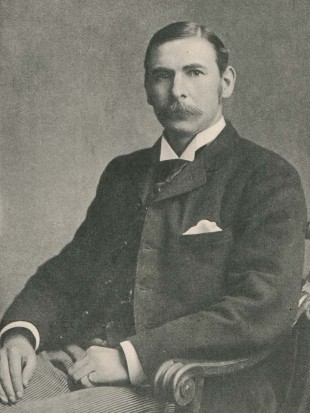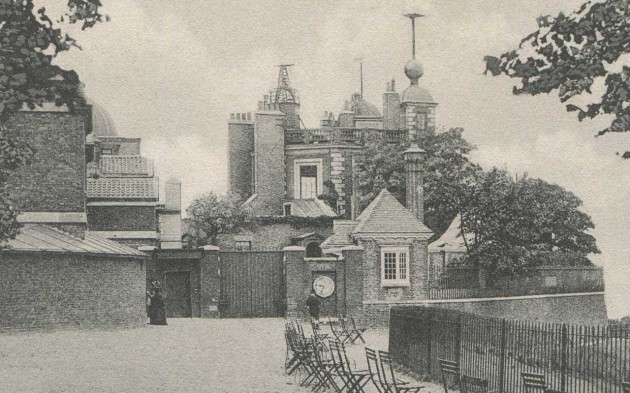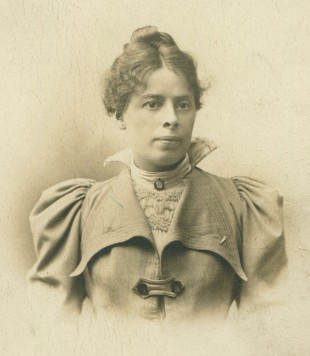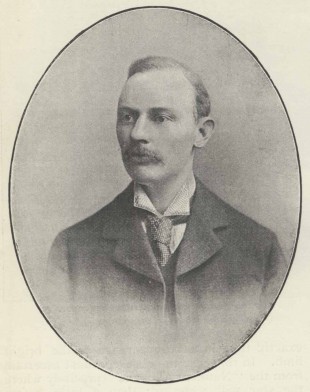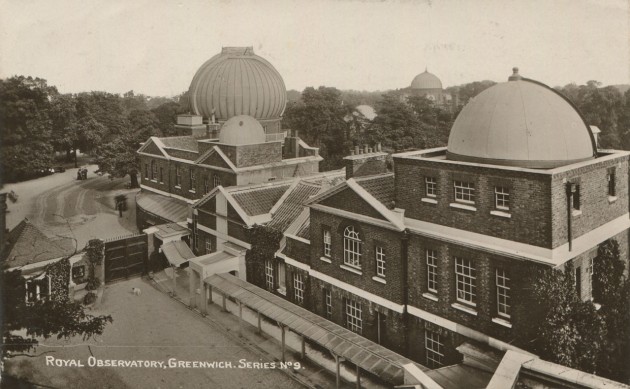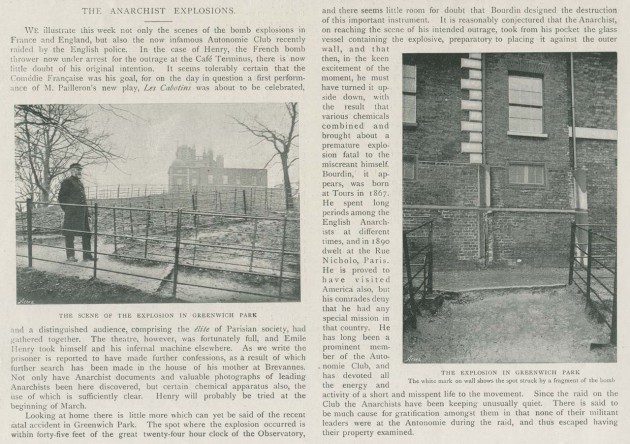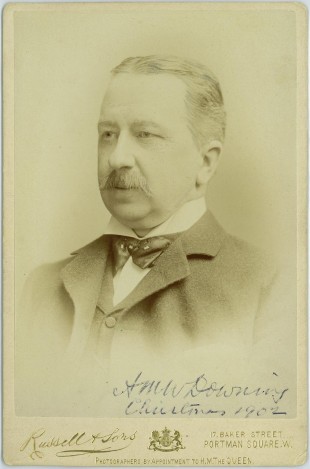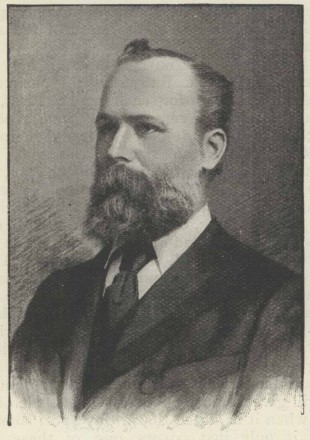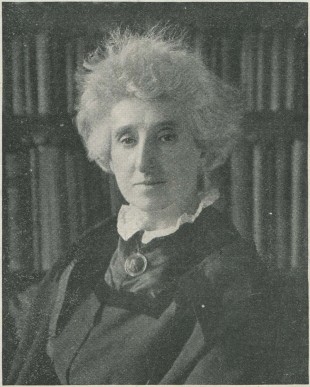…where east meets west
- Home
- Brief History
- The Greenwich Meridian
- Greenwich
(1675–1958) - Herstmonceux
(1948–1990) - Cambridge
(1990–1998) - Outstations (1822–1971)…
- – Chingford (1822–1924)
- – Deal
(1864–1927) - – Abinger
(1923–1957) - – Bristol & Bradford on Avon
(1939–1948) - – Bath
(1939–1949) - – Hartland
(1955–1967) - – Cape of Good Hope
(1959–1971)
- Administration…
- – Funding
- – Governance
- – Inventories
- – Pay
- – Regulations
- – Royal Warrants
- Contemporary Accounts
- People
- Publications
- Science
- Technology
- Telescopes
- Chronometers
- Clocks & Time
- Board of Longitude
- Libraries & Archives
- Visit
- Search
Christie’s ‘Lady Computers’ – the astrographic pioneers of Greenwich
The first women to be employed at the Royal Observatory in a professional capacity were Isabella Clemes, Alice Everett, Harriet Furniss, Edith Rix and Annie Russell. They were all employed as ‘Lady Computers’ between 1890 and 1895. Although the stories of Alice Everett and her Girton contemporary Annie Russell (later, Mrs Maunder) have been retold many times, those of the other three have languished in obscurity, as has the true reason for their employment.
All five women became members of the British Astronomical Association, but only Russell became a Fellow of the Royal Astronomical Society. Although she was not the first woman to be elected, it was her hitherto unrecognised influence that caused the Society to obtain the Supplemental Charter that gave women the undisputed legal right to become Fellows for the first time in 1916.In this tangled tale, which draws on significant new research and seeks to correct earlier misunderstandings, we discover that Rix attended an orphanage school even though she wasn’t an orphan and at the age of nineteen became a lifelong friend of Lewis Carroll who, in 1885, dedicated a work to her. Clemes on the other hand, was orphaned at the age of four, was the grand-daughter of a hatter, and was committed to an asylum within two years of starting work at Greenwich.
The whole story gets curiouser and curiouser the more deeply one delves. With significant papers missing from the archives and important data not entered in certain key registers, a conspiracy theorist might well speculate that the Observatory and Royal Astronomical Society had something to hide, rather than to celebrate.
Staffing problems in the late 1880s
By 1888, the new Astronomer Royal, William Christie had been in office for seven years and overseen a considerable expansion in the number of large telescopes both deployed and planned. But the number of staff both permanent and temporary had remained essentially unchanged.
Large telescopes acquired by Christie |
First agreed |
First light |
|
| Lassell 2-foot Reflector | 1883 | 1884 | |
| 28-inch Photo Visual Refractor | 1885 | 1893 | |
| 13-inch Astrographic Refractor | 1888 | 1890 | |
| Thompson 9-inch Photographic Refractor | 1890 | 1891 | |
| Large Altazimuth | 1892 | 1896 | |
| 26-inch Thompson Refractor | 1894 | 1897 | |
| 30-inch Thompson Reflector | 1895 | 1898 |
The staffing problem was raised by Christie at the annual meeting of the Board of Visitors, in June 1887 and again in June 1889. He ended his Reports as follows:
1887:
‘I believe that the maximum of efficiency at the minimum cost would be attained if an increase of work were met by an increase in the staff of computers, with due recognition of the position of two or three senior computers, and of the increased responsibility of the Assistants.’
1889:
‘In order to meet the pressure of computing work, the Admiralty have authorised an addition to the grant for Computers, and their number has accordingly been increased; but this does not meet the difficulty felt in providing for the proper supervision of the growing work of the Observatory, which can hardly be carried on efficiently unless some means are taken to strengthen the supervising staff.’
The table below shows the number of posts of different classes at the Observatory between 1887 and 1898.
Post |
1887 |
1888 |
1889 |
1890 |
1891 |
1892 |
1893 |
1894 |
1895 |
1896 |
1897 |
1898 |
|
| Chief Assistant | 1 | 1 | 1 | 1 | 1 | 1 | 1 | 1 | 1 | 2 | 2 | 2 | |
| 1st Class Assistant | 4 | 4 | 4 | 4 | 4 | 5 | 5 | 5 | 5 | – | – | – | |
| 2nd Class Assistant | 4 | 4 | 4 | 4 | 5 | 5 | 5 | 3* | 3* | – | – | – | |
| Assistant | – | – | – | – | – | – | – | – | – | 5 | 5 | 5 | |
| Higher Grade Estab. Computer | – | – | – | – | – | – | – | – | – | 2 | 2 | 2 | |
| Established Computer | – | – | – | – | – | – | – | – | – | ** | 4* | 5*** | |
| Supernumerary Computer | 13 | 14 | 17 | 19 | 17 | 18 | 23 | 23 | 24 | 26 | 24 | 23 | |
| Total+ established staff | 9 | 9 | 9 | 9 | 10 | 11 | 11 | 11 | 11 | 15 | 15 | 15 |
* 2 vacancies ** 6 vacancies *** 1 vacancy
+ excludes a civil service 2nd division clerk carrying out administrative duties
Figures are taken from the Annual Report (written at the end of each May)
The two Established Computer Grades were only introduced in 1896. All references to Computers on this page are to the Supernumerary Computers unless specifically stated otherwise.
Extra Computers were all very well (their number to rose from 14 in 1888 to 23 in 1893), but what Christie really wanted at the start of 1890 was more assistants to help run the new telescopes and for this there was no immediate prospect of money being provided. With the Astrographic Telescope expected to be delivered in the early spring (of 1890), he made the decision to ‘experiment’ and employ ‘Lady Computers’ to staff the new Astrographic Department he was about to set up under the superintendence of George Criswick. Only women who had attended a University Ladies’ College at Cambridge were employed. A total of four were taken on. They were Isabella Jane Clemes, Edith Mary Rix and Harriet Maud Furniss from Newnham and Alice Everett from Girton. They were all unmarried. Christie’s plan, it would seem, was that they should operate as a team under the supervision of Clemes, who was roughly 20 years older than the others. An entry in the Journal of the Chief Assistant (Herbert H Turner) tells us that all four started at the Observatory on 14 April 1890 and that they were initially set to work on re-computing the transit observations from 1886 (RGO7/29).
Although it is not known why or when Clemes resigned, she had definitely left by 7 October 1891 and most probably before the end of 1890. She was committed to Bethlem Hospital in 1892 and does not appear to have been replaced. Furniss resigned for reasons unknown on 31 January 1891 and was eventually replaced on 1 September by Annie Russell (RGO7/29, RGO7/140 & RGO7/29), a contemporary of Everett’s at Girton. Rix resigned in March 1892 on health grounds and was not replaced. The employment of women came to an end in 1895. Everett secured a position at the Observatory in Potsdam and left the Observatory on 5 July. Russell resigned a few months later on 31 October (RGO7/29/156) and married her colleague E Walter Maunder at the end of December. More detail is given below about the resignations, the attempts to find replacements and the ultimate ending of Christie’s ‘experiment’.
Name |
College |
MathematicalTripos* |
Start date |
Start
|
Monthlystartingsalary** |
Leave date |
|
| Clemes | Newnham | Jan 1881, senior optime | 1890, Apr 14 | 43 | £8 | 1891? | |
| Everett | Girton | Jun 1889, senior optime | 1890, Apr 14 |
25 | £6 | 1895, July 5+ |
|
| Rix | Newnham | Jun 1889, did not sit exam | 1890, Apr 14 | 24 | £4 | 1892, Mar 7+ | |
| Furniss | Newnham | Jun 1889, aegrotat | 1890, Apr 14 | c.23 | £4 | 1891, Jan 31+ | |
| Russell | Girton | Jun 1889, senior optime | 1891, Sep 1 |
23 | £4 | 1895, Oct 31+ | |
| * | Students were graded wrangler (first class), senior optime (second class) and junior optime (third class). Aegrotats were awarded to those who would have reached the required standard, but were unable to undertake their exams due to illness. In the early days, a considerable number of Newnham students did not attempt the tripos |
| ** | RGO7/140/115 & 73–4 |
| + | Dates from RGO7/266 and RGO7/140 |
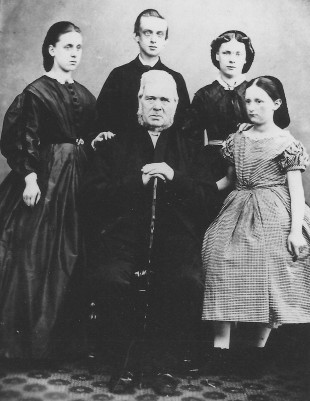
Isabella Clemes (left) with her brother Samuel, who is standing behind their grandfather William Clemes (seated). To his right are his grandnieces Harriet and Juliet Dunster. From a photograph taken in St Austell in the 1860s courtesy of Catherine Sheldon Lazier
Prior to 24 February 1881, women were not formally allowed to sit the Tripos exams, and could only be examined though a private arrangement with the examiners. If successful, they were awarded neither a certificate nor a degree by the University. After this date they had the automatic right to be examined and awarded certificates, but had to wait until 1923 to be awarded titular degrees and 1948 to be admitted to formal membership of the University and be permitted to graduate in the same manner as men.
The changes in 1881 came about following a special congregation that took place on 24 February at the University’s Senate House. It was there that a vote took place on the findings of a report of a Syndicate appointed in June 1880 (following the sensation caused by the success of Charlotte Scott in the January 1880 Mathematical Tripos exams where she beat most of the 102 men by coming eighth equal in the overall rankings) ‘to consider certain memorials as to the higher education of women’. The report which recommended, that subject to certain conditions of residence, female students should be admitted to the Tripos Examination and certificates issued, had previously been discussed at a meeting of the senate on 11 February. The proceedings of that meeting were reported in The Times on 14 February and were the subject of an extensive editorial in the paper on the following day. In the meantime, the results of the 104 men awarded a degree in the 1881 Mathematical Tripos had been published in The Times on 29 January, those of the four Girton Women on 1 February and that of the sole Newnham Candidate, Isabella Clemes, on 7 February. The success of Clemes was linked with the ongoing discussions in the Senate by the satirical magazine Punch, which on 19 February published the short paragraph titled Pessimismus Triumphatus that is reproduced below.

Pessimismus Triumphatus from the 19 February 1881 edition of Punch. The quote at the start is lifted directly from the 7 February edition of The Times. Prior to 1881 only twelve women are believed to have sat and passed the Cambridge Tripos. Of these, just three came from Newnham
A brief biography of each of the five women can be found towards the bottom of the page.
The mystery of the missing records
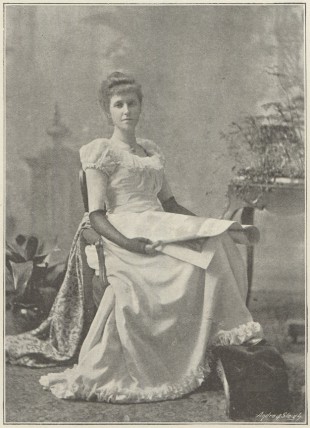
Alice Everett. Print by Andre & Sleigh from a photograph by Morgan & Kidd, Greenwich. From the 22 November 1893 edition of The Sketch
Even stranger, although the Observatory kept a Register of Computers, only the names of the two Girtonians (Everett and Russell) were entered (RGO7/266). As well as stating that both women worked in the Astrographic Department, it also states that Russell worked in the Heliographic Department. However as it is not possible to tell when this second piece of information was added; it is not clear if she was jointly assigned to the Heliographic Department from the start, or, (as seems more likely from the published observations and the Astronomer Royal’s 1892 Report), if she was assigned there at a later date, possibly in 1892. Although both women are listed as having obtained observing certificates for the Astrographic Telescope, neither is listed as having an observing certificate for the Photoheliograph. The evidence from their testimonials however indicates that this was an omission (RGO7/138). Information published elsewhere in Greenwich Observations (see below) makes it clear that irrespective of her involvement with the Heliographic Department, Russell was one of the individuals tasked with taking photographs with the Astrographic Telescope in 1893, 1894 and 1895. The names of the various women were also omitted from the list of computers awarded observing certificates (RGO7/136).
Although it is possible to think of a range of reasons from the innocent to the malign as to why individual documents may be missing from the archive and don’t appear in the catalogue, it is much more difficult to come up with a viable reason as to why the names of the three Newnham women were not entered into the Register of Computers, or why none of the women’s names appear in the list of computers awarded observing certificates.
In the case of Clemes, the only material that has been located in either the Observatory archive or Greenwich Observations that mentions her by name is the entry (mentioned above) in the Chief Assistant’s Journal giving her starting date and the following entry on a list of the four women’s salaries in the Lady Computer file: ‘Miss Clemes £8 a month’ (RGO7/140/115).
The intended role of the women
At the time of writing, the only known contemporary references (published or otherwise) to explicitly spell out the proposed role of the women are four brief articles (and/or their derivatives) that were published in 1890 and 1891. The first, titled Women at the Royal Observatory was published in the Pall Mall Gazette on Wednesday 23 April 1890 (and copied almost verbatim in a number of other papers and journals including: the Local Government Gazette on 24 April, the Aberdeen Journal on 26 April and The Leeds Mercury on 10 May). The second was published in The Times on 9 June 1890 and was a report about the annual visitation at the Observatory that had taken place two days earlier. The third was published in the Liverpool Mercury on 10 June 1890 and has the appearance of having been derived from the earlier report in The Times, but with some additional editorial comment. The fourth was an article by Isabella Clemes titled Woman’s place and work that was published in America on 20 June 1891 in The Churchman. The four articles are reproduced in full and in part below:
From the Pall Mall Gazette (23 April 1890)
‘It is not generally known that a department has been recently opened at the Royal Observatory, Greenwich, which is presided over entirely by women. Four ex-Newnham students, at the head of whom is Miss Clemes, a lady who was for some years resident in Manchester, are engaged in daily work at the Observatory. Their employment includes exact measurement from photographs, as well as actual photography and night observations. The arrangement is said to be only tentative, but if Miss Clemes and her associates succeed in making themselves useful the Women’s Department will doubtless become a permanent institution.’
From The Times (9 Jun 1890; p.12)
‘From the report [to the Board of Visitors] we learn the Admiralty have sanctioned the building of a store-house for the various portable instruments. The original idea was to have a building of one storey, but the Astronomer Royal now considers it desirable to modify this idea and erect a two-storey building, and thus provide additional computing-rooms, and also bed-rooms for the observers. In the olden days bed-rooms were provided, but Sir G. Airy found they were not needed and abolished them about 50 years ago; but the introduction of ladies as observers renders it necessary to revert to the old plan.
…
At present the staff consists of nine assistants, a second division clerk, and 12 computers. Of the 12 computers four are ladies, who have recently joined, and who may by described as students, as they are to be taught theoretical astronomy and to take and measure the photographs for the chart of the heavens. As these duties will involve attendance at all hours of the night, the necessity for sleeping accommodation will be at once evident, This is a new opening for ladies who have received a higher education, and doubtless when the Government sanctioned their employment, it was with a view to testing the capabilities of ladies for office and scientific work.’
From the Liverpool Mercury (10 June 1890)
‘The success of the ladies at the Cambridge mathematical examinations confirms the wisdom of a new departure at the Royal Observatory Greenwich. The Government recently decided to appoint two additional assistants to meet the increase of work to relieve the chief assistant of some of the duties of supervision [not true]. The staff now consists of nine assistants, a second division clerk, and twelve computers. Of the latter, four are ladies who have recently joined, and they are to be taught theoretical astronomy, and to take and measure photographs for the new chart of the heavens. This is a new opening for ladies who have received a higher education, and when the Government sanctioned their employment it was, no doubt, with the view of testing their work capabilities for office and scientific work. We do not believe there is the slightest reason to fear that the experiment will be a failure. Higher education has developed and is developing faculties which in the old days of imperfect culture were not supposed to exist; but it is obvious that great attainments would be of little value if they were not capable of practical application, and the step taken by the authorities at Greenwich in supplying a test is, therefore, worthy of all commendation.’
From The Churchman, Vol 63 p.987 (20 June 1891)
In writing of “Women’s Work in the Greenwich Observatory,” in England, Isabella J. Clemes says:
“Amongst the changes of the past year, that of the employment of women in the Royal Observatory at Greenwich has awakened a more widespread interest than at first sight appears to be justified, either by the social or the industrial importance of the movement.
The profession of astronomy is limited for men, and must necessarily, under the most favourable circumstances, be still more so for women. At the present time there are less than half a dozen women in England who are following astronomy as a profession, and it is improbable that there will ever be employment for more than twenty, either at Greenwich or elsewhere. Women, in as far as they are astronomers, are accumulators of facts rather than propounders of theories. They are busy emulating weather-beaten seamen in feats of vision, trying to acquire the delicate touch of the watchmaker, the fine ear of the organ builder, and the open mind of the student of Nature, In this way they learn the common rudiments of a working education, and become sharers of the popular interests of ordinary life.
Having briefly premised so much – having claimed for women astronomers the common insight gained from work, and the common sympathies that unite all workers – I may now consider, as far as may be, the uncommon elements of their employment – those details which belong to the province of practical astronomy. The work divides itself naturally into two parts: the first is the reduction of observations to a regular form, which is the occupation of the day, and the second is the taking of observations at night. The reductions, with which the women’s department is at present chiefly concerned, are those that relate to time. We get our time from Greenwich, but Greenwich must get it every day, if possible, from the sun and stars. To get it roughly within a few seconds, is easy; but the effort to reach perfection is always a difficult task, and to obtain true time within a hundredth of a second involves much calculation. In this work there is a good deal of monotonous detail to be gone through; similar spaces must be measured over and over again, and the same calculations repeated day after day until they become merely mechanical. But in this, what hardship is there, what difficulty beyond the experience of ordinary workers? We see none; for everywhere all-pervading necessity is upon us – upon women as well as men – to follow the narrow way of patient, self-forgetting effectiveness if we would enter into life.
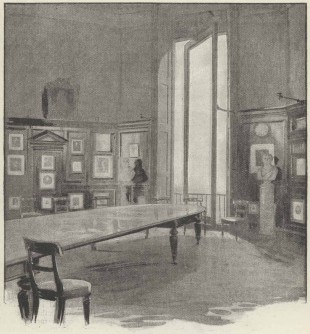
Internal view of the Octagon Room in the late 1890s. The women would have worked at the large table. From The Leisure Hour (1898)
The women at Greenwich, however are not always spinning webs of figures. During the last summer [1890] they were learning photography, and were being prepared for their at present occasional evening occupation – the special work for which they will ultimately be held responsible – that of taking photographs of the stars. To those who delight in connecting the present with the past, the building and surroundings of the Observatory, full as they are of historic associations, offer many and varied attractions. One room in particular, the octagon, is especially interesting, as being the observatory of Flamsteed, the first Astronomer Royal. It is here that the women do their computations, surrounded by the portraits of illustrious astronomers, who being dead yet speak, telling of the triumphs of industry, ingenuity, and genius, which recognize no distinction of sex, and are no prerogative of a class.”
It would seem from the Report in The Times that their reporter must have been one of the 250 guests who attended the annual visitation. Although much of the report (including the intended provision of sleeping accommodation) derives from the Annual Report, there is no mention (not even the tiniest hint) within the Annual Report itself of there being any women employed at the Observatory. The information about them can only have come from a conversation with the Observatory staff on the day. Although the reporter seemed to believe that the Government sanctioned their employment it is also entirely possible that officials at the Admiralty and the Treasury were not consulted. As things turned out, the designs for the new building underwent considerable alteration and the building was not completed until 1899. Sleeping provision is not thought to have been ultimately provided (see the section on the New Physical Building below).
The Astrographic programme and other photographic work done by the women
Ordered in 1888 and delivered in March1890 (RGO7/29/106), the 13-inch Astrographic Refractor was one of a number of similar telescopes that were commissioned around that time to take part of an international project (launched in 1887 by Ernest Mouchez, the director of the Paris Observatory) to produce a photographic map of the sky (Carte du Ciel). Made by Sir Howard Grubb of Dublin, the Greenwich instrument consisted of a 13-inch photographic refractor with a focal length of about 11 feet 3 inches (3.43m), firmly connected to a parallel 10-inch visual guiding telescope of the same focal length on a German Equatorial mount. It contributed to both the Carte du Ciel and the Astrographic Catalogue.
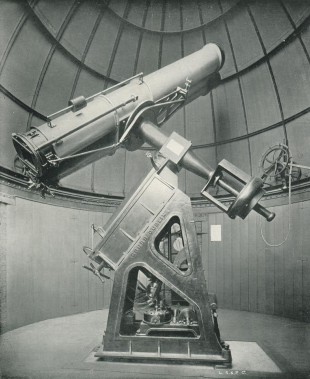
The Astrographic Refractor at Greenwich. Photo by the London Stereoscopic and Photographic Company. Known to have been published in Pearson's Magazine in 1896, this higher quality reproduction is taken from the Greenwich Astrographic Catalogue, Volume 1, (HMSO, 1904)
In his series of articles for the Leisure Hour that was published in the late 1890s, Maunder described the role of the observer and the photographs that they were required to take as follows:
‘Rigidly united with the 13-inch refractor, so that the two look like the two barrels of a huge double-barrelled gun, is a second telescope for the use of the observer. In its eye-piece are fixed two pairs of cross spider lines, commonly called wires, and a bright star, as near as possible to the centre of the field to be photographed, is brought to the junction of two wires. Should the star appear to move away from the wire, the observer has but to press one of two buttons on a little plate which he carries in his hand, and which is connected by an electric wire with the driving clock, to bring it back to its, position.
The photographs taken with this instrument are of two kinds. Those for the Great Chart have but a single exposure, but this lasts for forty minutes. Those for the Great Catalogue have three exposures on them, the three images of a star being some 20 seconds of arc apart. These exposures are of six minutes’, three minutes’, and twenty Seconds’ duration, and the last exposure is given as a test, since, if stars of the 9th magnitude are visible with an exposure of twenty seconds, stars of the 11th Magnitude should be visible with three minutes’ exposure.’
Unlike the transit and altazimuth observers whose observations were of a visual and almost instantaneous nature, the astrographic observers had to have the patience and concentration to sit glued to the eyepiece of their guiding telescope for up to 45 minutes for each observation.
A regular programme of taking photographic plates for the catalogue commenced in December 1891 and experimental measure of some of the photographs in 1893. In the meantime, the women were used from time to time to measure some of the solar plates.
Total number of retained photographs taken each year (from Astrographic Catalogue, Vol. I)
1890 |
1891 |
1892 |
1893 |
1894 |
1895 |
||
| 25 | 205 | 487 | 1011 | 694 | 547 |
The introductions to the published observations state that Everett, Rix and Russell all measured solar plates in 1891 and 1892, but only Russell in 1893, 1894 and 1895. The earliest published Measures of position and areas of sun spots and faculae to be made by each of the individuals was as follows: Rix (ER) on 15 February 1891. Everett (AE) on 17 March 1891 and Russell (AR) on 4 September 1892 (suggesting that the information contained in the introduction for 1891 was incorrect). As things turned out, the only woman to measure the astrographic plates from which published results were obtained was Everett. She was involved in measuring them from October 1894 to July 1895.
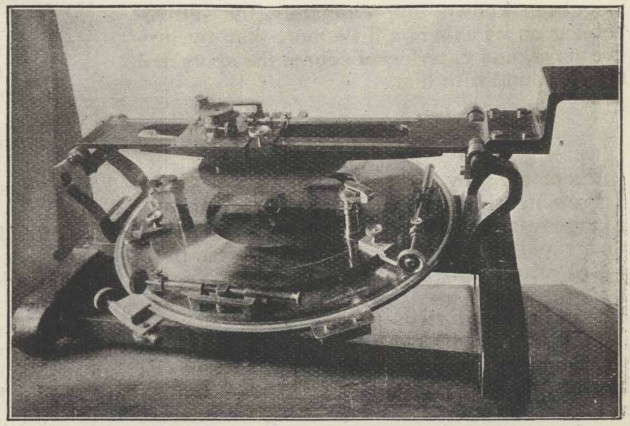
The Solar Micrometer for measuring the size and positions of sunspots on the photographic plates. Photo by E Walter Maunder. From The Leisure Hour (1898) p.376
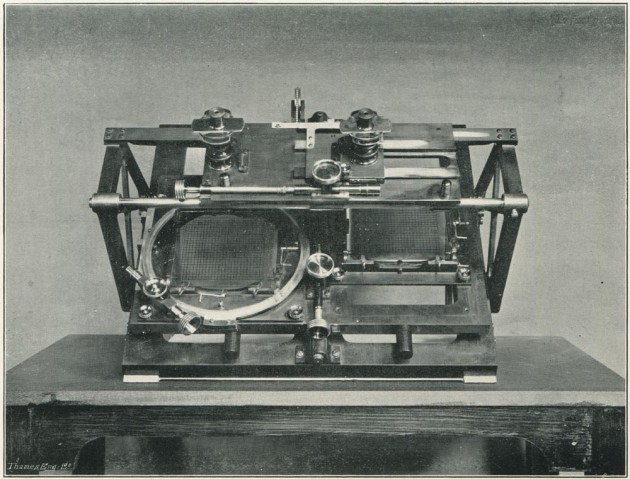
The Duplex Micrometer (by Troughton & Simms) for measuring the positions of the stars on the photographic plates. It was brought into use in January 1895. Photo by Thames Engineering Ltd. from the Greenwich Astrographic Catalogue, Volume 1, (HMSO, 1904)
At the start of each of the introductions to the volumes of Greenwich Observations, Christie outlined what the responsibilities of the various Assistants had been during the year in question. The following information has been extracted from the volumes for 1893, 1894 and 1895 and slightly re-ordered. The entries are highly unusual in that they also include the names of two of the Computers, namely Everett and Russell. The information provided by Christie gives no insight into whether either Everett or Russell took any of the photographs with the photoheliographs (neither of them is recorded as having an observing certificate for those instruments).
1893:
Mr Criswick superintended the Astrographic observations and reductions. Photographs with the Astrographic equatorial were generally taken by Mr. Criswick, Miss Everett, Miss Russell, or one of the senior Computers.
The measurement of the solar photographs and the superintendence of the reductions connected with them were entrusted to Mr. Maunder. Photographs of the Sun with the Thompson of Dallmeyer photoheliographs were taken by Mr. Maunder or by one of the Computers under his direction.
1894
Mr Criswick superintended the Astrographic observations and reductions. Photographs with the Astrographic equatorial were generally taken by Mr. Criswick, Miss Everett, Miss Russell, or one of the senior Computers.
The measurement of the solar photographs and the superintendence of the reductions connected with them were entrusted to Mr. Maunder. Photographs of the Sun with the Thompson of Dallmeyer photoheliographs were taken by Mr. Maunder or by one of the Computers under his direction.
Observations with the 28-inch refractor were made by Mr. Maunder and Mr. Lewis.
1895
Mr Criswick superintended the Astrographic observations and reductions. Photographs with the Astrographic equatorial were generally taken by Mr. Criswick, Mr. Hollis, Miss Everett, Miss Russell, or one of the senior Computers.
The measurement of the solar photographs and the superintendence of the reductions connected with them were entrusted to Mr. Maunder. Photographs of the Sun with the Thompson of Dallmeyer photoheliographs were taken by Mr. Maunder or by one of the Computers under his direction.
Observations with the 28-inch refractor were made by Mr. Maunder and Mr. Lewis.
An examination of the published volumes definitively shows that none of the women took any of the published transit observations in the year 1890, nor in 1891, 1892, 1893, 1894 or 1895.
Published one-off and ocassional observations with other instruments
Everett is recorded as having made 4 observations of Comet b 1893 with the Sheepshanks Equatorial on 16 & 22 July 1893, (seemingly under the direct supervision of Crommelin and Hollis), but did not make any observations of double stars, though she did do an analysis of the binary Iota Leonis which was published in MNRAS, having been communicated on her behalf by Thomas Lewis.
Kidwell (1984) reports that in 1892 both Everett and Russell observed the opposition of Mars with the ‘12.8 inch and 10-inch telescopes’. The 10-inch telescope is presumed to be the sighting telescope of the Astrographic. A further reference to the same observations can be found in Memoirs of the British Astronomical Association, vol.36, p.88 (1947), which seems to state that they also both observed the same event in 1894, but this time, with the new 28-inch Refractor.
Everett seems to have had a particularly enquiring mind, since as well as making the couple of observations with the Sheepshanks Equatorial mentioned above, she also seems to have taken it upon herself to become familiar with the operation of the transit circle. Following what appears to have been an unauthorised use of the instrument and submission of the results to Turner, he wrote what was possibly a testimonial (dated 8 May 1893). It stated:
‘Miss Alice Everett has submitted to me a number of observations of R.A. & N.P.D made (and reduced) by her with the Greenwich Transit Circle. If these had been submitted by a Computer who had obtained permission to qualify for a certificate for the transit circle, I would have remarked that they were not submitted quite in the usual form, and that several discrepancies were left which might have been corrected. That at the same time it was more satisfactory to have observations submitted independently of their accordance, as this was evidence that they had not been carefully selected and after referring the reductions back for correction, should have signed the certificate. ...’ (RGO7/140/144)
Additional information about Everett and Russell from their testimonials
Christie only appears to have written testimonials for Everett and Russell. He wrote two for Everett; the first was in November 1892 when she applied for a job at the Dunsink Observatory. The second was in 1895 after she had handed in her notice. The first was based on a sheet of information dated 14 November 1892 which was written by Everett herself. The second was based on information dated 27 June 1895 which was supplied by Chriswick (RGO7/138).
As well as confirming the information in the sections above, Everett indicates that in her leisure time she had also ‘observed occultations & phenomena of Jupiter’s satellites, and also practised hundreds of artificial occultatations’ as well as taking a number ‘of eye-and-ear transits with a 3-inch telescope’.
She also states that she had frequently been on duty for taking the daily solar photographs and did a regular night duty with the Astrographic Telescope with the ‘watch sometimes extending to 7 hours duration’. She also mentions that that the work in the Astrographic department ‘which, though increasing,’ took up comparatively little of her time (at that point) and that as a result she had shared in the computations generally and reduced observations for other departments which included originally transits (as mentioned above), but also more recently those of zenith distance.
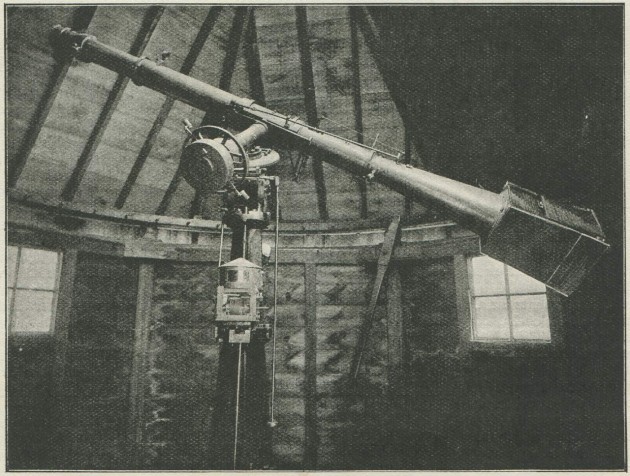
The photoheliograph as configured between 1890 and 1895. The new secondary magnifier (right) was added on 2 April 1884. Photo by E Walter Maunder. From The Leisure Hour (1898) p.376
Criswick’s statement about Everett is interesting as it re-writes the early history of the Astrographic Project. It starts by saying that Everett ‘was engaged on the meridian transit work till the middle of June 1891, and was then transferred to the Astrographic Depart[ment] ...’. What he should have said, was that she was engaged to work in the Astrographic Department but was largely deployed on meridian transit work until June 1891 when the initial commissioning of the Astrographic Telescope was completed. Criswick also confirms that from the beginning of 1892, Everett was almost exclusively employed on Astrographic work. Interestingly he ends his statement by specifically saying that she was ‘Qualified for [the] Transit Circle and Sheepshank Equatorial observations’. It’s still not clear though if she gained observing certificates for those instruments. One suspects not. It was probably Criswick’s inadvertent re-writing of the project’s early history together with the sparsity of information about Clemes and Furniss in the files, that has caused later historians to misunderstand the true nature of Christie’s ‘Experiment’.
In May 1897, Christie wrote a short testimonial for Russell (by then Mrs Maunder) in support of a grant application she had made to her old College at Cambridge. The unsigned and undated handwritten notes (RGO7/138) on which this appears to have been based state that she observed with the Astrographic Telescope until 5 July 1895 (the day Everett left) and that the preliminary measures and computations of the Astrographic work were to a large extent made by her. It also states that she ‘frequently took Sun pictures’ with the Thompson and Dallmeyer Photoheliographs and that from July 1894 she was entirely engaged on heliographic work and that she was exceedingly had-working and conscientious.
In her notes Everett makes reference to the fact that she is very strong (something she must have felt strongly about given that Rix had had to resign because of her health), but also feels the need to spell out that she should not be barred from the Dunsink post on the grounds of her gender, writing: ‘Miss Russell and I seem to work along quite naturally in the midst of them [the men] here. Of course there are two of us, but we are not always present together’. Once Everett had gone however, it was clearly deemed unwise for Russell to continue with night shifts as an observer on the Astrographic Telescope.
An earlier offer to Agnes Clerke
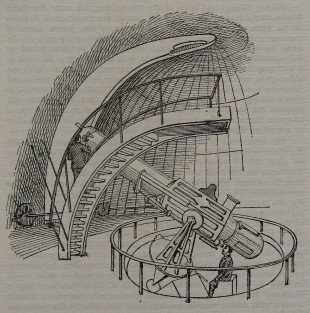
The Lassell Telescope in its dome at Greenwich. Sketched from life on 27 January 1888 (RGO7/29) and originally published by the Pall Mall Gazette on 30 January 1888. This copy is reproduced from Cudworth's: Life and Correspondence of Abraham Sharp (London, 1889)
On the second page of the letter, she wrote: ‘I was offered last week a small appointment in the Royal Observatory and refused it’ she then went on to explain how the offer came about and why she had turned it down. The letter continued.
‘The plan was first mooted in the spring, but more or less confidentially …It’s great attraction for me then consisted in the suggestion that I might have the exclusive use of the Lassell reflector for observing according to any plan I fancied’.
She then expressed her disappointment that ‘when the formal proposal came it included no express arrangements for observing’ The post on offer was a ‘supernumerary computership’, at eight pounds a month. She was also told that Rix was also being engaged. What she didn’t know, was that no sooner had the initial suggestion been aired (possibly by Turner), than serious plans began to evolve for redeveloping the whole of the south end of the Observatory site where the telescope was located. Those plans culminated in the building of the New Physical Observatory with the Lassell Dome relocated to the top of its central tower. As well as not being aware of the changed plans for the telescope, Clerke was probably not aware that in its current location it had a very poor horizon, particularly to the south where the nearby trees severely interfered with its effective use.
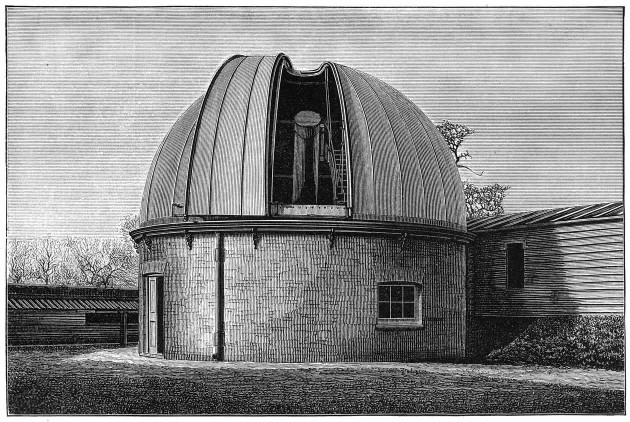
The Lassell 2-foot Reflector in the Lassell Dome at Greenwich. It was dismounted in 1892 and replaced with the 12.8-inch Merz Refractor. There are no know images of the Refractor in the dome. From: A Handbook of Descriptive and Practical Astronomy, Volume 2, Fourth Edition (London 1890) by George F Chambers
Taking what Clerke (who didn’t attend a University Ladies’ College) wrote at face value, it would appear that Rix was the first of the four Cambridge women to be offered and to accept a post at the Observatory. Given that Clemes (who graduated a year before Turner and possibly knew him from that time) was about the same age and paid at the same rate that Clerke had been offered, it seems likely that Christie envisaged her as a suitable substitute. The question therefore arises how and when the channel of communication was opened up between Christie and the women he ended up taking on.
Did the idea of appointing a team of women to run the Astrographic programme evolve out of the earlier offer to Agnes Clerke, or was it in fact a largely or entirely separate development, but one, which once formulated, where Christie felt obliged, as a matter of courtesy, to offer a leading role to Clerke? On balance, the weight of evidence (detailed below), seems to point towards the second scenario.
In a later letter to Gill dated 1 June 1890, Clerke was to write somewhat scathingly of the women Christie had taken on:
‘I hear they work very well, but take more coaching than men, because they want to understand more. I should think no educated woman would accept such a post, with such a minute salary, three pounds a month for the inferiors, unless with a view to training for something higher; and getting into a mechanical routine would be fatal to that end’. (RGO15/126/183)
Who she had got her information from is not stated, but as can be seen from the table towards the top of the page she was ill informed about the salaries that the women received.
Women and the Astrographic units in other observatories
Christie was not the only observatory director to take on women specifically to measure the astrographic plates, but he may well have been the first and he may have jumped the gun for his own political ends. The idea of employing women to measure the plates had been floated by Mouchez at the conference of the International Committee of the Carte du Ceil that Christie had attended in Paris in September 1889. As Charlotte Biggs explains, in her paper Photography and the labour history of astrometry: The Carte du Ciel, Mouchez envisaged the creation of ‘a central bureau of measurements, publication and distribution of the photographs and documents pertaining to the Carte du Ciel’, believing that it could be achieved at a reasonable cost, ‘if women were employed for the purpose, as had been done successfully by Bouquet de la Grye for the analysis of Transit of Venus plates, and Gould in the United States.’ Although the plan for a central bureau was not adopted, many of the participating institutions did choose to give the task of measuring their photographic plates to women.In her paper The work of women in astronomy (published in 1899), Dr. Dorothea Klumpke states that no less than seven of the eighteen observatories participating in the Cart du Ceil had women employed to measure them. They were: Paris, Cape of Good Hope, Helsingfors, Toulouse, Potsdam, Greenwich and Oxford. Also on the list, should have been the Melbourne observatory which by 1898 also had a woman working for it. The plates at Paris were measured by a team of four women under the direction of Klumpke herself in her capacity as the first Director of the micrometric service which had been established by Mouchez in February 1892 at the Bureau of Measurements.
Why Cambridge women and not others?
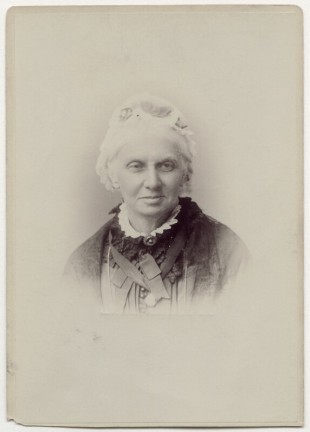
Anne Clough, Mistress of Newnham and President of the Association of Women Teachers. Albumen cabinet card by an unknown photographer, 1880–1892. � National Portrait Gallery, London. Reproduced under a Creative Commons Attribution-NonCommercial-NoDerivs 3.0 Unported (CC BY-NC-ND 3.0) licence (see below)
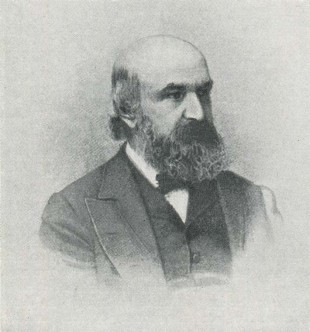
John Couch Adams. From a lithograph engraved by GJ Stodard from a photograph by JE Mayall and originally published in Nature on 14 October 1886 and later in Hutchinson's Splendour of the Heavens (1923)
Although, in February 1890, Christie’s scheme was clearly open to women from any University Ladies’ College and was being promoted by Herbert Rix (Assistant Secretary at the Royal Society), Miss Dorothea Beale (who was in the process of setting up St Hilda’s at Oxford and was Headmistress of Cheltenham Ladies College), Miss Constance Elder (who had attended Newnham and was Secretary of the Association of Women Teachers whose president was Miss Anne Clough, the Mistress of Newnham) and Avril Heyman Johnson (Mrs Arthur Johnson, Secretary of The Association for the Education of Women in Oxford), the appointment of the four Cambridge women was largely settled before applications were received from further afield. That the Cambridge applicants appear to have had a head start, may have been a coincidence, but may also be because the idea of employing Cambridge women may have come from a Cambridge man, and possibly from one of the Visitors either at the 1889 Visitation or at meeting of one of the societies later that year.
At their meeting in June 1889, the Board of Visitors are known to have discussed the Observatory’s staffing problems. Unfortunately, there is no record of what was said, only of the two resolutions that were passed (ADM190/6). The first, proposed by James Whitbread Lee Glaisher (son of Airy’s Assistant James Glaisher) and seconded by John Couch Adams, was for the appointment of a Deputy Chief Assistant. The second, proposed by Glaisher and seconded by the Earl of Rosse was for the appointment of an additional First Class Assistant. Different members of the Board are known to have had very different views on the education of women. The first edition of the Handbook of courses open to women in British, continental and Canadian universities was published in 1896. It tells us that by the academic year 1895–96 just 2% of Cambridge lecturers still closed their lectures to women. Amongst those five individuals were Sir George Stokes, who was Chairman of the Board from 1886–90, and Glaisher. On the other hand, Adams was on the Council of Newnham College and had been since 1880. He had also successfully employed two women Computers at the Cambridge Observatory (a Miss Hardy who worked there from 1876 until 1881 and Anne Walker who had been taken on in 1882 and was effectively a third assistant). Also on the Board was Arthur Cayley, who had been President of Newnham College since 1880 and the Sadleirian Professor of Pure Mathematics since 1863. It is possible that either Cayley or Adams suggested to Christie or Turner, that they could plug the staffing gap by employing women mathematicians from Cambridge as Computers. Interestingly none of Christie’s Reports to the Visitors ever mentioned the fact that women had been employed.
Looking now specifically at the four individuals who were initially appointed: Edith Rix was the cousin of Herbert Rix and Isabella Clemes was treasurer of the Association of Women Teachers in 1891 and may well have held this position in the preceding year(s). It could have been these connections that gave them a head start over the other potential candidates. Of Harriet Furniss’s connections, nothing is known.
Alice Everett, on the other hand, was very well connected though her father, who since 1867, had been Professor of Natural Philosophy at Queen’s College, Belfast and a fellow of the Royal Society (of London) since 1879. Before she was born, he had been Professor of Mathematics at King’s College, Nova Scotia, where he had established an observatory and at the time of her birth, he was assistant to the mathematics professor at Glasgow, where he had worked for a time in the laboratory of William Thomson (later Lord Kelvin). It was Thomson who sponsored Everett for fellowship of the Royal Society of Edinburgh in 1863 and it was Thomson who was headed the list of the fourteen proposers for his fellowship of the Royal Society (of London) (click here to view his nomination form). Amongst his other proposers there were three who were on the Observatory’s Board of Vistors in the late 18880s: Airy, De La Rue and Clifton. It was also Thomson who in 1890, replaced Stokes, both as President of the Royal Society (of London) and also as Chairman of the Board of Visitors. It has to be said however, that Thomson’s involvement with the Observatory did not begin until after the four women had taken up their positions. When asked in 1893 in an interview for The Sketch about how she had acquired her position, Everett replied: ‘That is a long story’ and went on to say:
‘The question of employing women at the Royal Observatory arose when the new photographic section was started, and Mrs. Huggins, who, like her distinguished husband, has earned a world-wide reputation as an astronomer, interested herself, I believe, in the matter. The first I heard of it was when the Observatory authorities wrote to ask if I would come.’
Regrettably (as already stated), there is no record of the correspondence in the Observatory files. William Huggins, on the other hand, had been a member of the Board of Visitors since 1871 and both he and his wife Margaret were good friends with Agnes Clerke. Despite the fact that the first mention in The Times of women being invited to a visitation does not occur until 1890, it is quite possible that Margaret was a regular guest at the annual visitations each June (RGO7/14, which has not yet been examined, might verify this). As to who it was that suggested Everett as a suitable candidate, we are, alas, none the wiser.
Pay
Although better educated than most of the Observatory’s Assistants the pay and conditions of the Lady Computers were broadly the same as those of the existing Boy Computers who were typically paid between £3 and £8 a month. The table below has been compiled from information in RGO7/266 and RGO7/133 and shows the actual salaries of the Boy Computers who were in employment on 1 July 1888.
Monthly
|
Name(s) |
Length of service
|
||
| £8 | Power | 12y + break in service | ||
| £5.15s | Pead Dolman |
10y 4m (age c.25) 6y 2m |
||
| £5.10s | McClellan* | 8y 9m | ||
| £5 | Woodgate Fisher Robinson |
5y 2m 4y 9m 5y 2m |
||
| £4.5s | Wise Finch* |
3y 2m 3y 5m |
||
| £4 | Pilkington Barrow |
2y 4m 2y 1 m |
||
| £3.15s | Hope* Letchford* |
3y 2m 2y 11m |
||
| £3.5s | Cochrane | 0y 11 m | ||
| *Mag & Met Computer |
A letter dated 6 February 1890 from Christie to Dorothea Beale (RGO7/140/10), gives an idea of his initial thinking on the salaries he was prepared to pay:
‘For a lady with her [Miss Dymond’s] qualifications I would propose £6 a month as the initial salary with a prospect of rising gradually to £10 a month or thereabouts. The salary is, I know, small but it may be supplemented by extra payment for observing out of office hours, which might add £20 or £30 a year and if the new departure turns out as successful as I hope, I may be able to get more funds for lady computers.’
With the letter, he enclosed a copy of the Regulations for boy Computers (more on these below) stating ‘to which (for official reasons) it is desirable to assimilate those for ladies at any rate at the start’.
By the time it came to replacing those who had left, the salary on offer was much reduced. When Russell first wrote to Christie in January 1891 expressing an interest in the post that Everett had just told her was about to be vacated by Furniss, she did so in the expectation that the salary would be £6 a month as that is what Everett had been paid (she was also ranked marginally higher than Everett in the Cambridge Tripos). When an offer finally came in July, the pay on offer was only £4 a month. When she queried this (RGO7/140/73) she was essentially told to take it of leave it as the salary on offer was dictated by the Observatory’s own finances.
Later that year, while attempting to recruit a replacement for Clemes, Turner said in a letter to Constance Elder, to whom he was writing on 22 December for help in the recruitment process (RGO7/140/16):
‘The work would appear to be more particularly suitable for those enthusiastic about science than for those whom salary is a consideration of the first importance, We now know a little more clearly what the observatory funds can afford and the Astronomer Royal is prepared to offer £4 a month to begin with, to be increased to £5 as soon as efficiency in the use of the Photographic Equatorial is acquired.’
Despite also writing to all the promising candidates who had been turned down in early 1890, the Observatory was unable to find a candidate who was prepared to accept the money on offer. As a result, Russell turned out to be the last of the Lady Computers to be recruited.
A comparison of what the women earned with the cost of putting them through University makes interesting reading. According to the 1896 edition of the Handbook of courses open to women in British, continental and Canadian universities, fees at Girton for board, lodging and tuition were £35 a term, whilst those at Newnham varied from 25 to 32 guineas (£26.5s to £33.12s).
Working hours and holidays
The 1888 version of Form 134 ‘Regulations for Supernumerary Computers’ sets out the working hours as follows:
‘The hours of attendance are from 9 a.m. to 4.30 p.m., one hour being allowed for lunch (on Saturday 9 a.m. to 2 p.m., with not allowance for lunch), and the strictest punctuality will be enforced.’
‘Holidays not exceeding 24 days in the year will be granted at the discretion of the Astronomer Royal.’
In practice, the women worked a variation of those hours because of their additional observing duties. The actual hours they were required to serve was spelt out by Turner wrote in a letter he wrote to a job applicant (Constance Marks) on 21 December 1891 (RGO7/140/27).
‘The hours are 9–1 every week day; and 2 to 4½ on 3 afternoons a week; with observing on 3 nights, the length of a night’s work depending of course on the weather, but not exceeding 3 to 4 hours.’
Fixed term or open ended contacts?
In a letter written to Christie on 7 March 1892 announcing Rix’s resignation, her mother wrote: ‘She, & we, are more sorry than we can say, that she is forced to give up so honourable & interesting a position; at least under three years, ...’ (RGO7/140/90). This has been interpreted by Brück to mean that her appointment was for a fixed period of three years in the first instance. It is not known if such a time limit applied to Clemes, Furniss and Everett. Clemes and Furniss both resigned long before three years had passed. Everett however remained at the Observatory for over five years. There is no correspondence known that suggests that her contact was ever extended once an initial three years were up. Nor is there any evidence to suggest that Russell was employed on anything other than an open ended contract.
Segregation from the Boy Computers
The arrival of the four women in 1890 must have come as a shock to the other Observatory staff. Given that they were paid about the same as the boys, but better qualified than most of the men, it would be surprising if their arrival at the Observatory wasn’t seen as a threat by at least some of them. As well as their gender, the strong regional accents of the women would have made them stand out from the locally recruited boys. Furniss was from Cornwall, as was Clemes who was largely brought up in Yorkshire, Everett was from Glasgow, but brought up in Ireland and Rix was from Beccles on the Suffolk / Norfolk border.
It’s clear from the article in The Churchman (above), that the women (at least to start with) did all their computations in the Octagon Room, which had been brought back into temporary use for this purpose between the autumn of 1887 and the spring of 1888 while the existing computing rooms were being extended. In his 1890 Report to the Board of Visitors, Christie made the somewhat mysterious comment that the room had been ‘assigned as a private room to the Computers’. It would appear that it was only the team of women who were assigned to the Octagon Room at this time. Rather than being a deliberate attempt to segregate them from the men, this may have been simply a practical arrangement as the Octagon Room was probably the only place in the Observatory where, at that time, four desk spaces could be provided for the new department. Given that the women would also have needed toilet facilities, it is possible that ones more suitable for their use would have been closer to hand. Clearly anything practical to do with the use of the Astrographic telescope would have taken place in the photographic dark-rooms attached to the newly extended main computing room at the west end of what today is usually referred to as the Meridian Building, or in the telescope dome above them. It is not known at present where the plate measuring machines were located at that time. Since both the telescope and the plate measuring machines were used by the men, the women were not segregated for the whole of their working week.
Building building everwhere!
During the whole time that the women were at the Observatory, building work was taking place somewhere or other on the site. The various works and their duration are listed below.:
| 1890 | Porter’s Lodge/Gate House (Courtyard) |
|
| 1891 | Transit Pavilion (Courtyard) |
|
| 1891–99 | New Physical Building (South Building) | |
| 1893–94 | Construction of the Onion Dome for the Great Equatorial (28-inch) Telescope |
|
| 1894–95 | Major repairs to Astrographic Dome after the shutter was blown off |
|
| 1894–96 | Altazimuth Pavilion |
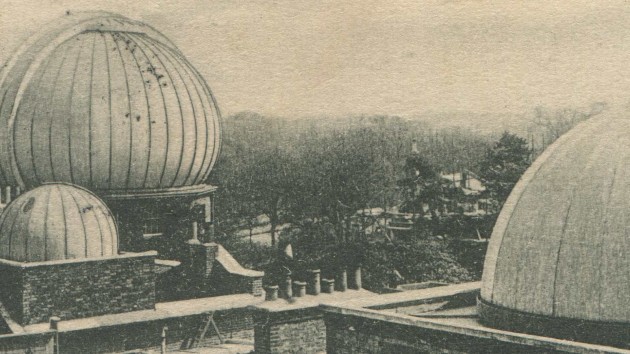
In this earlier view, from 1895, the dome of the Astrographic Telescope is once again on the right. Amongst the trees to its left, the Altazimuth Pavilion is under construction. Photo by York & Son. Detail from a postcard published anonymously
Although the building activity may have added a sense of excitement for the women at the start, the never ending works, with their accompanying noise and dust must have been a serious irritation and distraction at times.
Disasters in the dome
The Journal kept by the Chief Assistant (RGO7/29) shows that 1894 was an eventful year for the Astrographic Telescope. The year got off to a bad start when in the evening of the 2 January: severe weather with snow set in and the observer (unnamed, but one or more of at least five possible people including Russell and Everett) left the dome open all night. By the following morning, the telescope and the inside of the dome were covered in snow which fortunately had not melted and was presumably shovelled out.
The second disaster was much more serious and occurred at the end of the year on 22 December. At 11.32 in the morning, the shutter of the dome was ripped off by the wind and fell into the courtyard below, breaking a few tiles and damaging the roof of the covered way by the entrance to the Airy Transit Circle on the way down. The ‘head piece’ fell inside the dome where it just missed one of the boy computers, Charles Davidson, who was at work printing reticules. This incident put the telescope out of action for two months while the dome was repaired. It came back into use on 22 February 1895.
The anarchist bomb – Thursday 15 February 1894
At about 4.45 in the afternoon of Thursday 15 February 1894, a small bomb exploded in Greenwich Park on the zigzag path that (in those days) climbed the slopes to the north-west corner of the Observatory. At the time of the explosion, it was being carried by Martial Bourdin, a French anarchist when lost his hand as a result and subsequently died. It is unclear either what the target was, or why the bomb went off when it did. In the account in the weekly magazine Black and White (below), it is suggested that Bourdin’s aim was to blow up the Gate Clock and that he accidently triggered the bomb too soon as he approached the Observatory. Other reports suggest that the bomb exploded as a result of him tripping on the path.
It seems likely that neither Russell nor Everett were present at Observatory at the time of the explosion. Their working day would either have ended either at 4.30, or at 1.00 if it was one of the days on which they were scheduled to observe. Given that the bomb exploded about half an hour before sunset, they would be unlikely to have reported so early for their evening duty even if it was one of their observing days. If they were in Greenwich at the time, it is likely that they would have heard the explosion. Amongst those staff who were known to be at the Observatory when the bomb exploded were the two Assistants Thackeray and Hollis and the Gate Porter William McManus. The Astronomer Royal himself was not present. He had left shortly beforehand for a long weekend on his yacht which he kept at Sandwich on the Kent coast (RGO7/30).
It is planned to write up this incident more fully at a future date. In the meantime, more information can be read on this blog by Rebekah Higgitt and this blog by Bob Davenport.
The move to the New Physical Building
When the New Physical Building was conceived, it was designed to meet a variety of pressing requirements, including a new computing room for the recently formed Astrographic Branch. Built in stages, the central tower (minus the dome) was completed first, followed by the south wing, which was completed after many delays on 20 April 1894. The Photoheliograph and its hut were mounted on the concrete terrace roof of the south wing for daily observation of the Sun on 26 April. The three floors were initially used as follows. The attic floor was used to house the staff of the Astrographic Branch; the main (middle floor) was used to house the Heliographic and Altazimuth Branches, whilst the lower floor was fitted up as the Mechanics’ workshop, with a gas engine and dynamo for electric lighting.
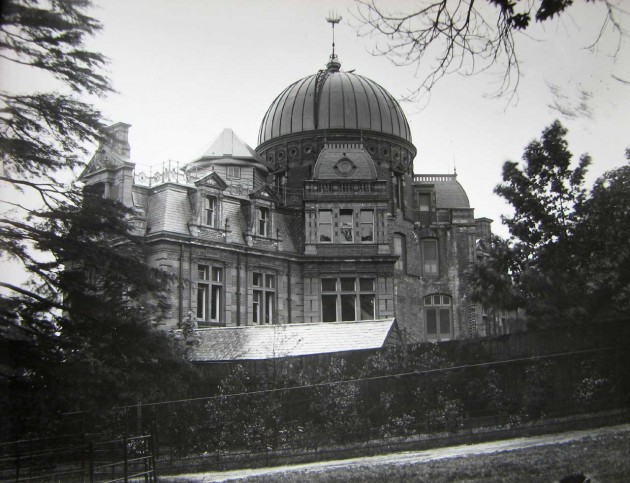
The New Physical Building in the summer of 1897 before the east wing was completed. The south wing where the Astrographic and Heliographic Departments were relocated is on the left. The hut on the roof housed the photoheliograph. Photograph reproduced by permission of the Greenwich Heritage Centre (see below). A copy of the photo was published in the 17 July 1897 edition of the Illustrated London News
Lodgings
Little information is available as to where the five women lived. The list below shows their known addresses on specific dates.
| Clemes | 1890, Dec 31*** | 1 Highbury Terrace, N [5]. |
|
| 1891, Dec 26+ | 19 Somerset Terrace, Tavistock Square, W.C. | ||
| Furniss | 1890, Dec 30* | 9 Crooms Hill | |
| Rix | 1890, Dec 30**** | 9 Crooms Hill | |
| 1892, Jun 30*** | Crooms Hill | ||
| Everett | 1890, Dec 31*** | 8 Gloucester Place (now 8 Gloucester Circus) | |
| 1891, Apr 5***** | 8 Gloucester Place |
||
| 1892, Feb 12** | 8 Gloucester Place |
||
| 1892, Jun 30*** | 9 Crooms Hill | ||
| 1893, Jun 30*** | 18 The Circus (now 38 Gloucester Circus) | ||
| 1894, Jun 30*** | 18 The Circus |
||
| Russell | 1892, Feb 12** | 16 The Circus (now 36 Gloucester Circus) | |
| 1894, Jun 30*** | 16 The Circus |
||
| 1895, Sep 30++ | 16 The Circus |
* Resignation letter (RGO7/140/96) **Nomination form for fellowship of Royal Astronomical Society
*** List of Members of the British Astronomical Association (1890, 1892, 1893, 1894)
**** Inferred from letter from Mrs Rix to Christie (RGO7/140/85)
***** Census + Letterhead University Association of Women Teachers (RGO7/23)
++ Resignation letter (RGO7/138)
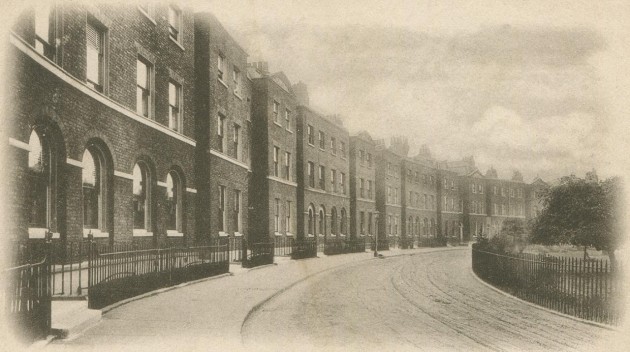
Looking westwards along The Circus. Number 18 is the first house from the left not to have arched windows. Number 16 is two doors to its right. Gloucester Place was on the other side of the circus, with number 8 being more of less opposite. From postcard No. 630 published by Perkins Son & Venimore (PS&V) in 1904
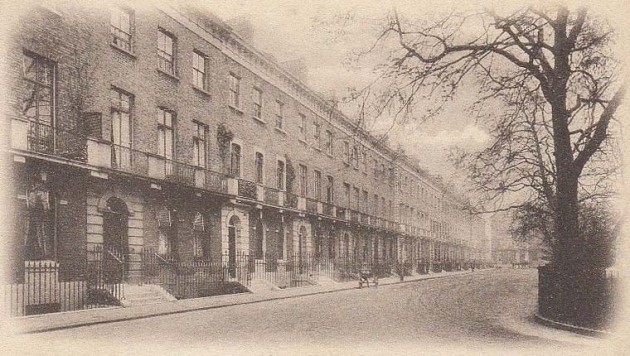
Looking Eastwards along Gloucester Place towards Greenwich Park. Number eight where Everett lived for a while is the fourth house from the far end of the terrace on the left. All the houses to its left have since been demolished. From postcard No. 654 published by Perkins Son & Venimore (PS&V) in 1904
All the houses in the above list (except those where Clemes lived) were located roughly 600m from the Observatory and within just a few minutes walk of each other close to the north west corner of the Park with easy access to either of Greenwich’s two stations (Greenwich and the now demolished Greenwich Park). By contrast, most of the Assistants lived on higher ground on the opposite side of the Park. Between 1885 and 1888, three of them, Maunder, Hollis and Lewis moved into newly built houses in Ulundi Road, staying until 1895, 1896 and 1917 respectively. They were joined in 1893 by Crommelin who moved away in 1894, only to return in 1899.
Regulations for the appointment of Supernumerary Computers
By 1858, candidates for the post of Supernumerary Computer were generally appointed by competitive examination amongst 13 and 14 year olds from the local schools. Although, at that time, there was no upper age limit to those who might be employed, the poor wages, temporary nature of the posts and a general lack of vacant posts at the assistant level, meant that most moved on relatively quickly. Examination for promotion to and within the Assistant Grade (for trial of competency) began for the first time after the fourth assistant Hugh Breen handed in his resignation in November 1858.
Candidates hoping to be employed as Supernumerary Computers needed to have a certain level of literacy and numeracy skills. In 1857, the requirements were listed by Airy on what was known as Form 134 (RGO7/6), which was presumably sent out to prospective candidates. By 1888, Form 134 had evolved into a formal set of ‘Regulations for Supernumerary Computers’ (RGO7/6). As well as listing the subjects of examination (‘Writing from dictation, to test hand-writing, spelling, and punctuation. Arithmetic, including extraction of square roots, and use of logarithms. Algebra, to quadratic equations inclusive.’), it had six main clauses. The first stated that candidates for the examination needed to be between the ages of 14 and 18 years, and that ‘every Computer will be liable to be discharged at the age of 23 unless special circumstances should make it desirable to retain his services’. The second stated that starting pay was normally £3 a month and that increments were granted ‘at the discretion of the Astronomer Royal’. The third gave details about the notice period. The fourth listed the hours of attendance. The fifth gave details of annual leave and the sixth stated that Computers were required to live within about a mile of the Observatory. The key changes from 1858 were the newly specified age limits and the requirement to live within a stated distance of the Observatory. The provision for the discharge of Computers at the age of 23 was introduced by Christie on 29 January 1883 and come into effect on 1 January 1884 (RGO7/133).
Interstingly, the 1888 Regulations for Supernumerary Computers did not state that only men were eligible to apply for a post. When an enquiry about the ‘Lady Computer’ posts was made of the Astronomer Royal in February 1892 by a Mrs Allen (a local parent) on behalf of her 15 year old daughter, she received a reply from Turner on his behalf which enclosed details of the competitive examinations and stated ‘that he was directed to enquire’ if she (the daughter) would be able to pass them (RGO7/140/100). This would seem to imply that at this point in time (if only briefly), Christie was not only prepared to take highly educated women onto the staff, but that he was also prepared to consider employing teenage girls on the same basis as teenage boys. As things turned out however, neither Miss Allen nor any other schoolgirl was ever taken on as a Computer by him. Nor are any known to have sat the exams.
When Form 134 was republished in August 1911, although there were several minor changes from those of 1888, the main change was the lowering of the age of discharge (unless special circumstances applied) from 23 to 21. (RGO7/140)
Regulations for the appointment of Second Class Assistants and the eligiblility of women to apply
It has long been held by historians, that women were not eligible to apply for the Assistant posts at the Observatory. Although none were appointed and none seem to have applied, an examination of the evidence suggests that they were not necessarily barred by the regulations.
Ignoring for a moment the question of eligibility on the grounds of gender, in 1890, Christie would have been unable to appoint the four women he took on as Assistants, firstly because there were no vacancies and the number of posts was strictly regulated by the Government and secondly because such posts had to be filled by open competition and could no longer be filled at the whim of the Astronomer Royal as they had been for many years under Airy, his predecessor. Christie did however have complete control over the hiring and firing of the Computers and was in a position to pay the women from this budget, but in order to do this, he had to waive:
1. The requirement for the women to take the entry exams.
2. The age limits in force in 1888.
3. His stipulations on the normal starting salary.
4. Any real element of competition (as the women, most certainly Russell, seem to have been appointed on a first come first served basis)
The splitting of the Assistant grade into First and Second Class Assistant in 1872 coincided with the introduction of open competitive examinations administered by the Civil Service Commissioners. Between 1872 and 1896, a total of eight Second Class Assistant appointments were made.
Exam Date |
Appt. Date |
Name |
Age requirement |
Probation (months) |
|
| 1872, Dec 10 | 1873, Jan 17 | Downing | 18–25 | 6 | |
| 1873, Sep 16 | 1873, Nov 6 | Maunder | 18–25 | 6 | |
| 1875, Jan 26 | 1875, Feb 25 | Thackeray | 18–25 | 6 | |
| 1880, Apr 27 | 1881, Jan 24 | Lewis | 18–25 | 6 | |
| 1881, Oct 28 | 1881, Nov 22 | Hollis | 18–25 | 6 | |
| 1891, Mar 23 | 1891, May 11 | Crommelin | 21–30 | 24 | |
| 1891, Dec 28 | 1892, Feb 8 | Bryant | 21–30 | 24 | |
| 1891, Dec 28 | 1892, Feb 12 | Hudson | 21–30 | 24 |
The first five appointments were made under the General Regulations that applied to all Civil Service posts appointed by open competitive examination, together with the Special Regulations that applied specifically to those posts at the Observatory. In 1872, the Special Regulations stipulated that entry to the examination was restricted to people of age 18 to 25 (CSC6/1/69). Therefore if a Computer hadn’t obtained promotion by the age of 26, he would have no prospect of ever being taken on as a permanent member of staff at the Observatory. With vacancies at the Junior Assistant grade being rare and normally only arising when an Assistant died or retired, some Computers would have had virtually no chance of ever gaining promotion, no matter how good they were. The same age limits applied for the next four appointments, the last two of which took place in 1881.
Neither the General or Special Regulations for Downing’s post specifically stated that only men were eligible to apply for a post. In fact, paragraph 2 of the versions of the General Regulations that applied to Downing, Maunder and Thackeray seem to state quite the opposite (RGO6/7, CSC6/1/69 & CSC6/1/138):
‘The examinations will be open, with such exceptions under such conditions as may be laid down, to all natural-born subjects of Her Majesty, being of good health and character.’
Much the same form of words appears at the start of paragraph 3 of the General Regulations that were in force when Lewis and Hollis were appointed (CSC6/2/132 & RGO8/31 & RGO7/8):
‘The examinations are open, under such general restrictions as may be laid down, to all natural-born subjects of Her Majesty, being of the requisite age, health and character.’
When entry to the Assistant level posts by open competitive examination commenced in 1872, the University Women’s Colleges were in an embryonic state and it seems unlikely that any thought was given by the Admiralty or Astronomer Royal to the fact that women might be tempted to apply. Although the General and Special Regulations make frequent use of the word ‘candidate’, the pronoun ‘he’ is also occasionally used in the Special Regulations. The pronoun ‘she’ however is not. Precisely how the wording might have been interpreted had a woman applied is not known.
Click here to view the Special Regulations for the post of Second Class (Junior) Assistant the issued on 29 October 1872. Click here to view the General Regulations as amended on 9 November 1875. Click here for alternative link. Click here to view the Special Regulations for the post of Second Class (Junior) Assistant the issued on 14 December 1874. Click here for alternative link.
After 1881, there were no further appointments until 1891. That appointment was followed by two more in early 1892. Not being satisfied that candidates appointed though open competition always proved to be competent observers, Christie managed to persuade the Commissioners (and presumably the Admiralty) to change the rules. As well as raising the lower age bar to 21 and the upper to 30, instead of making the three appointments by open competition, they were made using a ‘limited competition of nominated candidates’. The exams for the three posts took place on 23 March and 28 December 1891 (CSC6/5/168 & 218).
Under this regime, Christie touted for suitable candidates who might be known to his astronomer friends, who advertised the post on his behalf with the instructions:
‘Candidates are requested to apply without delay to the Astronomer Royal, Royal Observatory, Greenwich, who will require to be satisfied as to their practical acquaintance with astronomy, before nominating them.’ (RGO7/6)
Writing to a potential Candidate on 27 Nov 1891, Turner stated:
‘He [the Astronomer Royal] will be happy to nominate you on receiving a testimonial from some competent person that you are able to take transits & find the time from your observations and observe zenith distances etc: in fact have such elementary practical knowledge of Observatory work as would obviate the necessity for detailed instruction on your appointment here. Should your experience not extend exactly in this direction perhaps a few visits to the Cambridge Observatory might supplement it in the required manner.’ (RGO7/6)
It would be interesting to know what discussions took place between Christie and the women employees when these posts became available. Although Everett mentions them in the interview that she gave to The Sketch in 1893, she provides very little detail:
‘It is doubtful whether women are eligible for the examination, and candidates must be nominated by the Astronomer Royal, who refused to take the responsibility when we applied. Of course, we were new and untried. Things must, I suppose, develop by degrees. We hold a rather non-descript position at present.’
Christie was certainly wary of how the Civil Service Commissioners might regard the employment of women if they applied for an established post at the Observatory. This was explained in a letter dated 15 July from Turner to Lucy Worsfold who had enquired about posts at the Observatory in the summer of 1890.
‘I beg to inform you that 4 ladies are at the present time employed as Computers at this Observatory, these being the only appointments in the hands of the Astronomer Royal, and therefore the only ones in which it is possible to employ ladies without raising the question of their recognition by the Civil Service Commissioners.’ (RGO7/140/63)
Given that Christie was:
a) wary of the Commissioners’ approach to women
b) able to vet and veto potential applicants
c) able to recruit degree level Lady Computers who were willing to do the same
work as a Second Class Assistant for less than half the pay,
he was hardly likely to encourage his Lady Computers to apply for a Second Class Assistant post, nor to provide them with the necessary observing experience on the Transit Circle that was required.
Could the reason that Clemes resigned be linked to the fact that as well as being barred from applying for the vacant post both on account of her age she may also have been blocked by Christie on account of her gender? And was a block on promotion at Greenwich on the grounds of gender the reason why Everett applied (unsuccessfully) for a post at the Dunsink Observatory in Dublin in late 1892
Unequal pay for equal qualifications?
The table below shows the starting salary and qualifications of all the Second Class Assistants, Lady Computers and Chief Assistants appointed between 1872 and 1896. Unlike the Assistant posts, the Lady Computer posts were not pensionable. The ranking given in the Cambridge maths tripos is the overall position amongst all the male students who sat the exams in a particular year. Dyson was head hunted as Chief Assistant, and unlike Crommelin, Bryant and Hudson, did not have to satisfy the Astronomer Royal in advance with his practical skills in astronomy (which at that stage he didn’t have).
Appt. Date |
Name |
Post |
Starting Salary |
Degree |
|
| 1873, Jan 17 | Downing | 2nd Class Assist. | £200 | Trinity College Dublin (BA 1871, MA 1881, Hon PhD 1893) | |
| 1873, Nov 6 | Maunder | 2nd Class Assist. | £200 | University College (1864-7) & King's College London (1872 as an occasional student) | |
| 1875, Feb 25 | Thackeray | 2nd Class Assist. | £200 | n/a | |
| 1881, Jan 24 | Lewis | 2nd Class Assist. | £200 | n/a | |
| 1881, Nov 22 | Hollis | 2nd Class Assist. | £200 | Cambridge, senior optime (ranked 37th, 1880 maths tripos) | |
| 1890, Apr 14 | Clemes | Lady Computer | £96 |
Cambridge, senior optime (1881 maths tripos) |
|
| 1890, Apr 14 | Everett | Lady Computer | £72 |
Cambridge, senior optime (ranked between brackets 43 and 47, 1889 maths tripos). Royal Universitiy of Ireland (BA 1887, MA 1889) |
|
| 1890, Apr 14 | Furniss | Lady Computer | £48 | Cambridge, aegrotat (maths tripos) |
|
| 1890, Apr 14 | Rix | Lady Computer | £48 | Cambridge, studied but did not sit maths tripos | |
| 1891, May 11 | Crommelin | 2nd Class Assist. | £200 | Cambridge, wrangler (ranked 27th, 1886 maths tripos) | |
| 1891, Sep 1 | Russell | Lady Computer | £48 | Cambridge, senior optime (ranked between brackets 41 and 43, 1889 maths tripos) | |
| 1892, Feb 8 | Bryant | 2nd Class Assist. | £200 | Cambridge, wrangler (ranked 21st, 1887 maths tripos) | |
| 1892, Feb 12 | Hudson | 2nd Class Assist. | £200 | Cambridge, wrangler (ranked 17th, 1890 maths tripos) | |
| 1896, Mar 1 | Dyson | Chief Assistant | £500 | Cambridge, wrangler (ranked 2nd, 1890 maths tripos) |
Resignations, replacements and the ending of the ‘experiment’ – the sequence of events
The first of the five Greenwich women who is known to have resigned is Furniss. Her letter of resignation giving a month’s notice is dated 30 December 1890 (RGO7/140/96). The reason for her resignation is not known. Soon after her resignation letter had been handed in, Everett wrote to Russell informing her of the impending vacancy. Russell then wrote to the Astronomer Royal on 13 January enclosing her testimonials and asking to be considered for the post (RGO7/140/69). Turner wrote back on 31 January saying that the Astronomer Royal did ‘not propose to consider the appointment of any other lady Computers at present, but that when occasion arrives he’ would communicate with her (RGO7/140/70). A Miss Tate who had studied mathematics at Somerville Hall and had missed the boat in 1890 wrote again to the Astronomer Royal on 18 Feb 1891 saying that she understood there was a vacancy (ROG7/140/49). She received a reply that there were no vacancies at present, but was contacted by Turner in November when there was one (see below). A Miss Edwards (who doesn’t seem to have had a university education) received a reply to her enquiry on 13 April, that there were at present no vacancies (RGO7/140/21). On 22 July, Russell wrote once again to Christie saying that she had ‘heard yesterday the vacancy ... would probably soon be filled up’ and reminding him of her earlier application (RGO7/140/71). She received an almost immediate reply from Turner stating that the Astronomer Royal was prepared to offer her the job at £4 a month (RGO7/140/72). Russell wrote back saying that she would like to accept the post but queried the salary as she was expecting to get £6 a month the same as Everett had received when she started. She also stated that she could enter work any time after the next three weeks (RGO7/140/73). Turner wrote back on 28 July on behalf of the Astronomer Royal stating that ‘he wishes me to state clearly the salary offered you is simply dictated by our own finances ... [and] is simply all we can afford’ (RGO7/140/74). Russell replied on 30 July accepting the post and asking if she could start work on 1 September (RGO7/140/75), which was agreed. In the eight month period between Furniss handing in her notice and Russell starting work, Christie took on just two new boys, Edney who started on 10 August and McManus who started on 25 August. This suggests that the delay in appointing Russell was probably driven by financial considerations and perhaps the slower than anticipated progress of fully commissioning the astrographic work rather than because there were any doubts at this stage about developing a team of women.
It is not known why of when Clemes resigned. We do know however from the Bethlem Hospital records, that in the late summer or early autumn of 1890 that she ‘thought 2 gentlemen were in love with her’. From snippets of information in the Greenwich files and elsewhere, it can be inferred that Clemes had probably left the Observatory by the end of 1890 (but after 15 July (RGO7/140/63) and that she had most certainly resigned by 7 October of the following year. On that date, Turner wrote to Olivia Dymond (who had applied too late to be originally considered in February 1890), and asked her if she would be interested in joining the other three ladies on the staff, explaining that ‘since it became apparent that the experiment was successful ... that it was desirable to make the department larger’ (RGO7/140/13). He also explained the salary that would be on offer (see above). The timing and content of Russell’s correspondence (above) suggests that the post she filled was definitely that of Furniss rather than that of Clemes.
The address given for Clemes in the first published membership list of the British Astronomical Association (which is dated 31 December 1890) is in central London. Although it is just possible that Clemes might have commuted to Greenwich, this seems highly unlikely as a) all the other staff lived within about a mile of the Observatory and b) she would have been expected to undertake some observing duties and in that case would not have been able to get back home. The absence of any published Measures of position and areas of sun spots and faculae to be made by Clemes also suggests that she had resigned by the spring of 1891. Although the article by Clemes about the women at Greenwich was published in June 1891 (see above), it may well have been written long before its publication or long after Clemes left Greenwich.
As well as writing to Dymond in the October of 1891, Turner also wrote to the former candidates Miss Tate on 4 November (ROG7/140/53), Miss Walter on 18 December (ROG7/140/59), Miss Prestidge on 18 & 21 December (ROG7/140/42), and Isabelle Marks on 21 December (ROG7/140/27) to see if they were still interested in working at the Observatory. He also wrote to Miss Elder of the Association of Women Teachers on 22 Dec 1891 asking for her help to find a suitable candidate. (RGO7/140/16). People were either otherwise engaged or unwilling to take the job on at the salary on offer and the recruitment drive ended.
The next member of staff to resign was Edith Rix. The events that lead up to her departure on 7 March 1892 began in the previous year when she had got caught in ‘the great gale’. This was a severe storm which traversed England on 11 November 1891, the like of which had not been seen for some time. As well as causing a considerable loss of life and property at sea, it did a large amount of damage on land. At the observatory, the Osler Anemometer was damaged. At 8.00 in the morning, the pressure had dropped below 29 inches across the whole of the country giving rise to strong winds varying between SSE and SSW at Greenwich and of hurricane strength at Dungeness. At Greenwich, the ozone levels were also very high and 0.886 inches of rain fell. Rix was unfortunate enough to get soaked on her way to work and when she returned home to her room, she found that the chimney pots had blown down; the house was full of smoke and that no fires or food was obtainable. Finding herself ‘very ill’, she made her way to a friend of the family in Guildford who wrote to Christie on 14 November explaining what had happened and that Rix had gone straight to bed where she had been ever since (RGO7/140/81). At the end of the month, Rix was still in Guilford, but well enough to write to Christie enclosing a Doctor’s certificate and asking for December off without pay in order to recover (RGO7/140/82). This was agreed by Christie who arranged for her to be paid sick pay at half the normal rate (RGO7/140/84). Over the next three months or so, a further nine letters were exchanged between Rix and Christie or her mother and Christie (RGO7/140/85–94). As they are jumbled in the archive, they are listed in chronological order below:
| Date | Ref | Correspondents | Notes | |
| 1891, Dec 3 | 87 | Mrs Rix to Christie | The tone of the letter is interesting and hints at more than a professional relationship. Why does the mother write: ‘I hope your dear little Boy is escaping measles’ and ‘An old servant of our’s who is married & has three children tells us she lived with you once’? Had the mother met Christie at the Observatory or did she write to everyone on such personal terms? |
|
| 1892, Jan 23 | 86 | Mrs Rix to Christie | The family were very grateful to Christie and Turner and thought them very kind. | |
| 1892, Jan 27 | 88 | Christie to Mrs Rix | Christie considered ‘that the work here is necessarily trying for a girl and it has been done under difficulties owing to our staffing [illegible][illegible] our Computing Rooms’ ... by why does he refer to Rix as a girl when she was a woman about to celebrate her 26th birthday? | |
| 1892, Jan 30 | 85 | Mrs Rix to Christie | Rix lived with Furniss until Furniss resigned. Furniss was known as Maud rather than Harriett. The landlady was very kind, but the one maid was ‘always of the most inefficient & common sort’ and meals were unpunctual. Consideration had been given after Furniss resigned to Rix boarding with a family. |
|
| 1892, Feb 15 | 89 | Rix to Christie | Rix was offered a post on the Labour Commission at £150 a year for five years, but turned it down because she preferred astronomy and the hours were slightly longer than at Greenwich. The letter was written at the Observatory suggesting that Rix had eventually returned to work. |
|
| 1892, Mar 7 | 90–91 | Mrs Rix to Christie | Rix parent’s decided it was time for Rix to leave Greenwich. This was on the basis of her continuing ill health and that it was ‘the heavy instruments’ which bothered her doctor and the late Arthur Carpenter. Rix was physically small. Rix and the family were more sorry than they could say that ‘she is forced to give up so honourable & interesting a position, at least under three years’. The letter ends ‘I trust your little boy is quite well & free from cold’. | |
| 1892, Mar 8 | 93 | Rix to Christie | Writing from Guildford, Rix explains that Turner had let her go at once on the previous day as she hadn’t been well and that she would like to come and thank him in person for his kindness and to say goodbye. | |
| 1892, Mar 19 | 92 | Christie to Mrs Rix | A short note expressing how sorry he was that Rix had had to give up on account of her strength. | |
| 1892, Mar 19 | 94 | Christie to Rix | Christie expresses his regret that the work was too much for her strength and that she had been struggling for longer than she ought and ‘how sorry we are that you have had to leave Greenwich’. |
Although Christie kept Rix’s job open for her during her illness, he also recruited three new boys in February 1891 (Lacy, Walter and Rendell) and a further six during the remainder of the year – one each in April, June, August and September and two in July. (RGO7/266).
If the failure to find a fourth university educated woman in the autumn of 1891 hadn’t been enough to cause Christie to pull the plug on his experiment, then the saga around Rix and her helicopter mother must have given him cause for thought. After Rix resigned, no further attempt was made to recruit any more women. Although the jobs of Everett and Russell were seemingly secure for an indefinite period, by the spring of 1892, Christie appears to have begun to make up his mind not to replace them when they did eventually leave. Boy Computers took over some of the work in the Astrographic Department and Russell appears to have spent less time working there, though she was still on the rota for taking photographs at night. Charles Davidson and Herbert Furner were awarded observing certificates on 1 December 1891 and Robert Rendell was awarded one on 15 December 1892 (RGO7/136)).
In response to a request from Ruth Livingston (a student who had just passed the Tripos at Girton) asking for her name to be put down for the vacant post, Turner sent a letter in July 1892 stating that ‘the Astronomer Royal requests me to inform you that he does not propose to make an addition to our staff at present but your application shall be noted’ (RGO7/140/106-114). In response to a later enquiry, Turner replied in May 1893, that ‘the astronomer Royal regrets that he does not see his way to offering you an engagement at present’ (RGO7/140/121). In a reply to another candidate in November 1893 Turner wrote that the Astronomer Royal regrets that at the present time there is no vacancy in the appointments about which you enquire (RGO7/140/123). Subsequent enquirers were also told there were no vacancies.
Everett eventually resigned on 5 July 1895 so that she could take up a post working on the Astrographic programme at the Observatory in Potsdam and Russell resigned a few months later on 31 October. Two months later, she married her colleague E. Walter Maunder. More on this below.
Following the awarding of an observing certificate to Rendell in December 1892, no more boys were awarded a Certificate for the Astrographic Telescope until 24 August 1894, when one was awarded to G.F. Johns. Roughly a year later, certificates were awarded to David Edney (12 July 1895), followed Charles Martin and R.W. Cheeseman (26 August 1895) (RGO7/136). On the face of it, Edney, Martin and Cheesman were trained up as replacements for Everett, Davidson, Furner (who all resigned within a month of one another) and Russell, who was removed from the roster with effect from 5 July 1895.
An examination of the Register of Computers (RGO7/266) suggest however that things may not have been this straight forward, as Martin resigned on 26 October 1895 (a week before Russell) to take up the post of Assistant at the Dunsink Observatory. One can imagine that on hearing this, that Everett and Russell must have been quite gutted as this was the same post that Everett had been unsuccessful in applying for back in 1892 when it had last become vacant. Since the next observing certificate for the Astrographic was not awarded until 4 March 1896, one has to wonder if Christie was acting as a guiding hand by giving Martin both the opportunity and encouragement to get himself qualified on the Astrographic specifically to gain experience with a photographic telescope in order to enhance his CV and hence his prospects of getting the appointment at Dunsink. This view is reinforced by the fact that following his resignation there was still a team of four boys to operate the telescope (Rendell, Johns, Edney and Cheeseman).
Observing Certificate |
Name |
Appointment date |
Resignation date |
Promotion
|
Age at promo. or resignation |
|
| 1891, Dec 1 | Davidson | 1890, Mar 10 | 1895, Jul 13 | * | 20y 4m | |
| 1891, Dec 1 | Furner | 1889, Mar 18 | 1895, Aug 2 | ** | 21y 10m | |
| 1892, Dec 15 | Rendell | 1892, Feb 9 | -- | 1896, May 21 |
22y 7m | |
| 1894, Aug 24 | Johns | 1892, Jun 27 | 1897, May 21 | *** | 19y 2m | |
| 1895, Jul 12 | Edney | 1891, Aug 10 | -- | 1896, May 21 | 20y 8m | |
| 1895, Aug 26 | Martin | 1889, Nov 11 | 1895, Oct 26 | -- | 20y 7m | |
| 1895, Aug 26 | Cheeseman | 1890, Dec 1 | 1900, Nov 23 | **** | 24y 11m | |
| 1896, Mar 4 | Bowyer | 1892, Apr 13 | -- | 1896, May 21 | 20y 10m | |
| * | Rejoined as Established Computer 1 Jun 1896 | |
| ** | Resigned due to illness, returned 1 Jan 1896. Promoted to Established Computer 26 Nov 1897 aged 24y 2m | |
| *** | To Cape Observatory as a Computer. Assistant, Perth (1901). Astrographic Assistant, Melbourne (1908) | |
| **** | To Cape Observatory as a Computer. Promoted to Established Computer (1901) |
Membership of the British Astronomical Association
The British Astronomical Association (BAA) was founded in the Autumn of 1890, with its first General Meeting being held on 24 October. Amongst those involved in its founding were two of the senior Greenwich Assistants, Maunder and Downing and their more junior colleague Hollis. Also instrumental was the amateur solar astronomer Elizabeth Brown. Clemes, Furniss, Rix and Everett all joined the Association before the end of the year, after which date, all prospective member had to be nominated and voted for in a ballot of the members. At the meeting held on 28 October 1891 (the second to be held after she joined the Observatory), Russell was nominated for membership. Her proposer was Everett and her seconder was Rix. She was elected (which required three quarters of the membership to vote for her) at the next meeting. This was held on 25 November.Between October 1890 and October 1895, members of the Observatory staff held the following offices:
October 1890 to October 1891 (Click here for full list)
Vice-President: Downing
Editor: Maunder
October 1891 to October 1892 (Click here for full list)
Vice-President: Downing
Editor: Maunder
October 1892 to October 1893 (Click here for full list)
President: Downing
Editor: Maunder
Director Mars section: Maunder
Council: Everett
October 1893 to October 1894 (Click here for full list)
President: Downing
Secretary: Everett
Editor: Maunder
October 1894 to October 1895 (Click here for full list)
President: Maunder
Vice-President: Downing
Secretary: Everett
Editor: Russell
Having left the Observatory, Clemes, Furniss, Rix and Everett all allowed their membership to lapse. All appear on the membership list dated 30 June 1892. Only Rix and Everett appear in the list dated June 1893. Rix does not however appear in the one for the following year. Both Everett and Rix did however rejoin. Everett was elected on 31 January 1900. Her address at that time was given as 11 Leopold Road, Ealing. Rix was elected on 28 October 1903 having been nominated by E Walter Maunder and seconded by Annie. Her address at that time was given as 1 Akehurst Gardens, Roehampton.
Rejection by the Royal Astronomical Society
The meeting of the Royal Astronomical Society (RAS) held on Friday 12 February 1892 was a significant one on two counts. Firstly it was the date when new officers and council members were elected and secondly, a provocative attempt was made to get Everett, Russell and Elizabeth Brown elected as fellows of the society, which at that point, had no female fellows.
The last woman to have been nominated was (Elizabeth) Isis Pogson whose nomination form is dated 12 July 1886. Her proposer was General Walker. On that occasion, at their meeting on 12 November, the Council of the Society decided that it should obtain a view from Counsel on the legality of admitting a woman because of the use of the pronoun ‘he’ throughout the Society’s Royal Charter. This was given at the next meeting on 10 December, in the form of a letter from George Chambers (currently missing) and also from Arthur Cowper Ranyard. Both were members of the Council and had trained for the Bar. Ranyard was of the view that women could be legally admitted. He made reference to various legal precedents, where the use of the word ‘he’ was also taken to mean ‘she’. They are summarised below together with his arguments:
Lord Bougham’s Act of 1850 (13+14 Vict. C.21 S.4) which stated that in all acts of Parliament ‘Words importing the masculine gender shall be deemed and taken to include females’.
R.v.Stubbs. 2.J.R.395 where it was decided that a woman could be elected as an overseer, although the masculine pronoun only was used in the 1601 act 43 Eliz C.2.S.4 which defined the persons who could be elected.
Dunne v. Dunne which was decided in 1855.
Having regard to those decisions and the arguments in Charlton v. Ling. L.R.4., C.P.374, that a woman could not vote for a member of Parliament, he came to the conclusion that unless it could be shown that a woman could not consistently exercise the rights and perform the duties of a Fellow, that the Council could be compelled to allow the name of a woman to go forward. He was also of the view that as the first Bye-law defined the object of the Society to be ‘for the encouragement and promotion of astronomy’ and that women could clearly do this.
The matter was deferred until the next Council meeting on 14 January 1887 at which the following 16 members were present: Glaisher (President and in the chair), Adams, Christie, Dunkin, Common, Knobel, Tupman, Capron, Chambers, Downing, Knott, Maunder, Noble, Ranyard, Stone and Tennant.
At the January meeting, Capron presented a second legal opinion, from Mr. Shebbeare of Lincoln’s Inn. He came to the opposite conclusion, as having regard to the social habits at the time when the Charter was granted, female Fellows are not likely to have been in contemplation at that time, and therefore as there are not words expressly including them, and the masculine pronoun is used throughout the Charter and Bye-Laws, and especially the Appendix of Forms, they must by taken as ‘excluded’ or not intended to be ‘included’. He went on to say usage and practice since the commencement of the society was consistent with this view. It was then proposed by Chambers and seconded by Tennant that Pogson’s nomination should be permitted to proceed in the normal way (i.e. it should be hung (suspended) in the meeting room of the society where it would remain until the ballot of members took place). The motion was carried by eight votes to five. Knobel, Common and Maunder entered a protest, but unfortunately the minutes shed no light on the reason why.
At the meeting that evening, the President made the following statement:
‘It is my duty to call attention to this nomination because it relates to a woman. There could be no question that at the foundation of the Society the admission of women was not contemplated; but it is doubtful whether, as a matter of law, either our Charter or our Bye-laws exclude them. The Council have had several legal opinions before them, and the majority of the Council are of opinion that they would not he justified in refusing to let this certificate go forward to the general body of Fellows to he dealt with by them as they think fit. It is not so prima facie invalid that the Council feel it their duty to keep it from the Fellows. They express no opinion whatever upon the general question. Those who feel that the admission of women is undesirable, or that it is a question which should be first considered at a General Meeting of the Society, have only to give their votes accordingly at the ballot in March. One black ball in four is sufficient to exclude a candidate. In voting adversely there could be nothing personal, as those who brought forward this candidate were aware that it was a new departure, and that her eligibility was questionable.’
At the Anniversary meeting of the society on 11 February 1887, Walker requested permission to withdraw Pogson’s nomination ‘as it was the wish of her friends that the general question of the eligibility of ladies for membership should first be decided.’ Although leave was granted and the nomination withdrawn, the Society appears to have failed to seek further clarification on the position of women or bring the matter before a General Meeting.
Interestingly, what does not seem to have been looked at by the lawyers was how societies that did admit women couched their rules and regulations. Were they couched in entirely neutral terms, and what use, if any, did they make of the words ‘he’ and ‘him’, and ‘she’ and her?
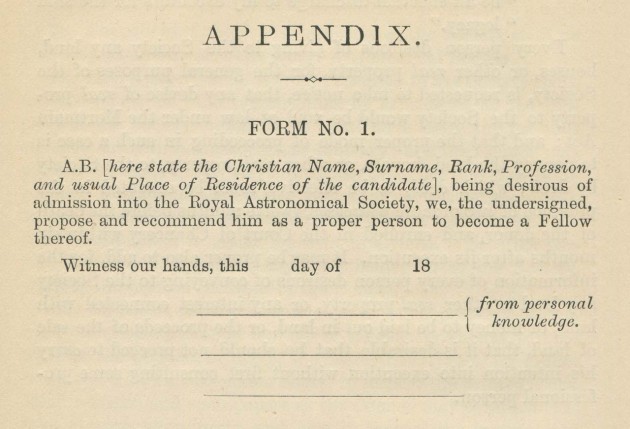
Form No. 1. Note the use of the word 'him' that Shebbeare argued meant women were intentionally excluded. From the Astronomer Royal's copy of the 1894 edition of the Royal Astronomical Society's Charter and Bye-laws
Moving on to Everett, Russell and Brown; each candidate needed a proposer and two seconders. Downing, the outgoing secretary of the society (and now the recently appointed Superintendent of the Nautical Almanac Office) was the proposer for Everett, whilst Maunder, who was one of two new secretaries to be elected at the meeting, was the proposer for Russell and a seconder for Brown. Of Everett’s two seconders, William Huggins had a wife (Margaret) who was a practicing astronomer and worked alongside him and Isaac Roberts (who later married Dorothea Klumpke).
Everett |
Russell |
Brown |
||
| Proposer | Arthur Downing | E. Walter Maunder | William Noble | |
| First seconder | William Huggins | J.G. Petrie | William Maw | |
| Second seconder | Isaac Roberts | William Schooling | E. Walter Maunder |
The completed nomination forms were unusual. Firstly they were all signed on the day of the meeting, 12 February 1892, (rather than in advance of the meeting as would more normally have been the case). Secondly, the details of all three of the women being nominated appear to have been completed by Maunder rather than the women themselves. And thirdly, and unsurprisingly, the printed word ‘him’ on each of the forms has been crossed our and replaced with the word ‘her’.
The names of the officers and Council members elected in February 1892 were: Knobel, Christie, Glaisher, Stone, Tennant, Common, Maunder, Turner, Huggins, Abney, Cayley, Cockle, Downing, Knott, McClean, Maw, Plummer, Raynard, Roberts, Sidgreaves and Spitta. Of these 21 individuals, five had signed the nomination papers. Four, including the Astronomer Royal, were on the staff of the Royal Observatory (Christie, Turner, Maunder and Downing) and six were on (or had been on) the Observatory’s Board of Visitors (Knobel – the new President, Tennant – the outgoing President, Glaisher, stone, Huggins and Cayley).
When the Council met on 8 April (Glaisher, Tennant, Cayley, Cockle and McClean were not present) and after some discussion, the following resolution was proposed by Huggins, seconded by Christie and carried.
‘The question of the election of women as Fellows having come before the Council, after a discussion it was resolved to take no action in the matter, as their admission did not appear to be clearly illegal.’
It was then proposed by Common and seconded by Sidgreaves as an amendment ‘That the nomination of the ladies seeking election tonight not being in the form prescribed by the Bye laws, their election be withdrawn and that the subject of the admission of ladies as Fellows be brought before a General Meeting of the Society for settlement.’ The amendment was lost, and it was proposed by Turner and seconded by Plummer, and carried, ‘that the original resolution be read by the Chairman at the general meeting of the Society that evening.’
Given that it was known in advance of the meeting that many of the individuals on the Council were supporters of the women and given too that Glaisher had been in the chair when Pogson’s nomination had been previously considered and bearing also in mind his attitude to women at Cambridge (see above), it has to be asked if his absence from the Council meeting was a diplomatic one? As the Council minutes do not list apologies for absence, it is possible that we may never know.
At the meeting of the Society at 8 o'clock that evening, the Chairman read out the resolution mentioned above (minutes of the meeting) and made the following statement:
‘I am instructed by the Council to say that the question of the election of women having come before them, it was resolved not to take any action in the matter as to their admission, but to leave it to the Fellows to take their own course. By that statement it must appear that the Council were not prepared to say that their admission was illegal, and therefore the first election is left in the hands of the Fellows present, At the same time any Fellows who give a vote must clearly understand that it is a question whether it is advisable that they should be admitted to the Society or not, and they must, each decide for themselves if it is for the benefit of the Society as a whole whether they should be elected or not. With these remarks I will simply leave it in the hands of the Fellows.’
After a flippant comment by Mr. Brett, Captain Abney entered a protest against the legality of the elections in case the women should be elected.
When it came to the vote, none of the women received the 75% of votes in their favour that they need to be elected (as required by the Bye-laws). What is not known, is of the votes that were cast against them, how may were cast on constitutional grounds, how many were cast because of a disapproval of women members for other reasons and how many were cast because of disapproval of the candidates as individuals. What is known however, is that once again, the Society did not take any steps in the aftermath of the vote to bring the subject of the admission of women before a General Meeting of the Society .
It is not known why Edith Rix, was not nominated alongside Everett and Russell in 1892, but the reason possibly lay in the fact that she had been on extended sick leave from the Observatory since 11 November 1891. She returned briefly to work at some point in February before effectively resigning on 7 March (see above).There are several other notable women such as Margaret Huggins and Agnes Clerke whose names might have been put forward for election at the same time as those of Everett, Russell and Brown. One can only speculate what discussions might have taken place between the various individuals concerned.
If the Greenwich women had been told (rightly or wrongly) they were ineligible to apply for the new Assistant post at the Observatory in 1891 (see above), they may have seen their application for fellowship as a means of making some headway in a profession and country that was dominated by men that didn’t involve rocking the boat at their place of work where possible dismissal might have followed. They had nothing to loose in trying to become Fellows and everything to gain. By contrast, had Margaret Huggins applied for Fellowship and been rejected, it could have made things difficult for her husband as a long standing officer and former president of the Society.
Cards of Admission to the Royal Astronomical Society
A few months after the rejection of Everett and Russell and Brown the Royal Astronomical Society made a conciliatory gesture. At the Council meeting on 10 June, ‘The following motion, of which notice had been given was proposed by Mr. Stone and seconded by Father Sidgreaves’:
‘That the President, with the consent of the Council be authorised to issue cards of admission to the ordinary meetings to such persons as it may be thought desirable to admit; the cards to be available for one session only.’
After some discussion, the resolution was carried, ‘it being understood that the session should be taken as running from November to June’. The following amendment was then proposed by Turner and seconded by Spita, but lost on a vote being taken:
‘That words be added to the above to the effect that ladies might bring a friend with them’.
It was then agreed that the President should prepare ‘a list of persons to whom he thought it desirable that these admission cards should be issued, and that the list should be sent to members of the Council for the expression of their opinion, it being understood that the adverse vote of one third of the whole Council veto any name.’
When the Council next met on 11 November, the President reported that cards had been sent to the Presidents and Secretaries of several scientific societies (unspecified) ‘and to the following ladies:- Miss E. Brown, Miss A.M. Clerke, Miss A. Everett, Miss Fawcett [possibly Caroline who became a member of the BAA in May 1892], Mrs Fisher, Miss Agnes Giberne, Mrs Huggins, and Miss A.S.D. Russell.’
The President then stated that the names of several other ladies had been suggested to him, but too late for him to submit to the Council. These were presumably read out as it was then ‘proposed by Turner, seconded by Gen[era]l Tennant, and carried, that the President should be authorised to issue invitations to the following five ladies:– Miss Ellen Clerke, Miss V. Common [presumed to be Violet, eldest daughter of Andrew Ainslie Common], Miss Amy Johnson [presumed to be the scientific author and previously a science teacher and headmistress of the Royal Academy, Inverness], Miss Meyer, and Miss Perrin.’
The Royal Astronomical Society reforms – the hidden influence of Annie Maunder and Frank Dyson
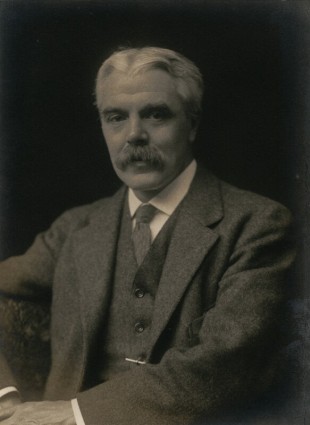
Frank Dyson, Astronomer Royal and one of the Society's Vice Presidents. Bromide print by Walter Stoneman, 1919. � National Portrait Gallery, London. Reproduced under a Creative Commons Attribution-NonCommercial-NoDerivs 3.0 Unported (CC BY-NC-ND 3.0) licence (see below)
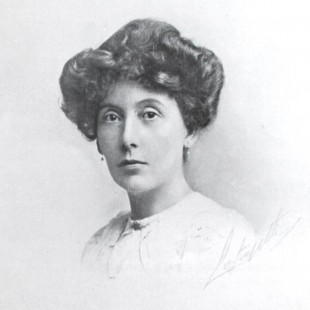
Fiammetta Wilson by Lafayette. From Knowledge and Illustrated Scientific News, vol. 12 (1915). Public Domain image via Wikipedia
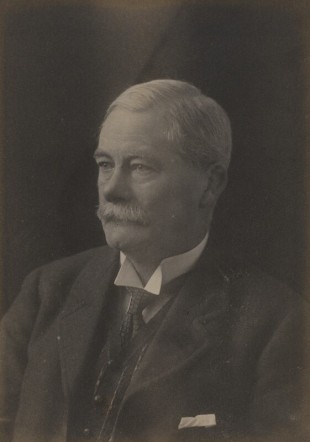
Herbert Hall Turner, Savilian Professor of Astronomy at Oxford, former Chief Assistant at Greenwich and one of the Society's Vice-Presidents. Bromide print by Walter Stoneman, 1918. � National Portrait Gallery, London. Reproduced under a Creative Commons Attribution-NonCommercial-NoDerivs 3.0 Unported (CC BY-NC-ND 3.0) licence (see below)
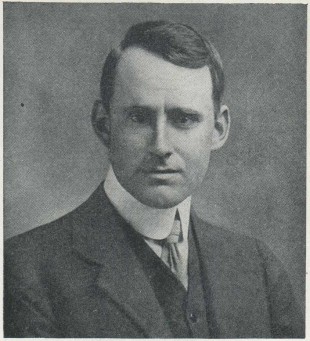
Arthur Eddington, Plumian Professor of Astronomy and Experimental Philosophy at Cambridge, former Chief Assistant at Greenwich and Secretary of the Society. Photo c.1914 by Elliott & Fry. From Hutchinson's Splendour of the Heavens (1923). Also published on 28 March 1914 by The Illustrated London News
This new attempt to get women elected turns out to have been kick-started by Leeson, a recently retired General Practitioner from Twickenham who had been a Fellow of the Geological Society since the 1880s, the Linnaean Society since 1892 and the Royal Astronomical Society since December 1911. On 19 November 1914, he wrote to the Assistant Secretary and chief administrator, William Wesley, asking for a form on which to nominate Fiammetta Wilson and adding by way of explanation:
‘I spoke to several [members] of the Council last meeting [on 13 November] & they seemed to favour the idea – I see there is nothing in the Bye Laws against it. …’
Leeson submitted the form on 8 December with an accompanying letter and a second letter addressed to the Council, which he asked to be read at their meeting on 11 December. In that letter, after singing Wilson’s praises, he explained that he could find nothing in the charter to exclude women from Fellowship and went on to say:
‘I desire particularly to state this is no subtle suffragette movement on my part. I am strongly – I might say bitterly opposed to granting the Parliamentary Franchise to women, but I cannot see why Sex should be any obstacle to the study & knowledge of Astronomy.’
He then mentioned that at the Linnean Society, ‘ladies were admitted some years ago’ with great success and in an attempt to highlight the strength of support for Wilson amongst the existing Fellows, that the nomination paper was signed by five Fellows (the signatures of just three were required) and that he could easily have got more signatures, but didn’t, because ‘he didn’t want to present a petition to the society’!
The informal discussions begun by Leeson on the 13 November were followed up by Turner, who is presumed to have written to the Secretary of the Society, Arthur Eddington on the subject. A reply from Eddington (see below) was sufficiently supportive for him to take the active step of asking Blagg if she would like to be nominated. A copy of the letter he wrote to her on 29 November is preserved in the Women’s Library at the LSE (9/22). After a couple of paragraphs on other matters, Turner broached the question of Fellowship:
‘I want to ask whether you would allow yourself to be proposed as a candidate for the Royal Astronomical Society. The Council long ago decided that there was no legal reason why ladies should not be admitted as full “fellows;” but it was made clear that there would be some opposition if any lady were proposed, & so no one would face it.
Now things have greatly changed. The presence of ladies at our meetings as invited guests has broken the ice: also ladies in the Brit, Ast. Assoc on Equal terms[:] & you will see from the enclosed letter [not present in the archive] from Prof. Eddington, the Secretary, that he thinks the moment is propitious.
Your known excellent work … make it certain that you would be welcome on any ground but that of a possible lingering objection to all women, which I frankly believe does not exist now.
…
I would try to get Mrs. Maunder to be a candidate also, but I fear she may not be able to afford it. Moreover as her husband is a Fellow & she gets the Monthly Notices (though his Copy) there is less reason than usual for her facing the expense. …
But if you could & would take a lead in this matter, you would, I feel sure, earn the gratitude of many of your sex who could scarcely move without some reputable leader and it would be a great pleasure to me personally, & to Mr Hardcastle I am sure, to be your supporters. I enclose the form that is submitted: & hope for your permission to send it to the Astronomer Royal & Mr Hardcastle.’ (9/22/03)
Blagg replied immediately accepting his offer but also querying some of the terms of the application. Turner received the letter on 2 December and responded immediately.
No details are known to survive of how, when or where the offer was made to Annie Maunder. The letter she sent Dyson on 4 December (catalogued as RGO8/132, but archived as RGO8/150/82) declining it must have shocked him, and was almost certainly the trigger that lead to the Society galvanising itself into action to obtain a Supplemental Charter in 1915 and then admitting its first women Fellows in 1916.
In her letter of 4 December, after thanking Dyson and Turner for their willingness to support her, Annie Maunder continued:
‘But 22 years ago, I was brought forward as a candidate for Fellowship, in company with two other women … in just this way. The Society then declined to express any corporate opinion on the eligibility of women for the Fellowship until some women had actually presented themselves for election. The election went against us. Of course I recognize, and have done so all along, that the Society is perfectly within its right and competence to restrict its Fellowship as it deems fit; in other words, I feel that women cannot claim the election of women as a right, and I am sure that our rejection was not intended to convey the slightest discourtesy to us, either as women or as individuals.
But just for these very reasons, I am bound to accept the decision then given, so far as I am concerned. If the Society should see fit, – seeing that I have already once applied, – to reverse its former decision, and grant admission without further application, I should value it exceedingly.
I have much appreciated the courtesy and honour which the Society has shown me, in inviting me to attend its Meetings as a guest. This was a gift on the part of the Society, and I have gratefully accepted it for 22 years. If now, of its own initiative it were to give me what it refused me before that would be a gracious act. But if I make a second application for it, it would imply that I was dissatisfied with what has already been done for me; and further, if I were again blackballed, – as might well be the case, – I should feel that I had placed myself in quite a false position.’
Her final paragraph included the following comment about Turner:
‘I had formed the impression, whether correct or not, that he [Turner] had blackballed me on the former occasion. Of course I understood that this did not express his personal objection to me, but was solely because I was a woman.’
As her husband had been at both the Council Meeting on 8 April 1892 and at the meeting were the vote was held later that day, it seems likely that her impression was well founded.
Within about a week of the two meetings held on 11 December, Eddington had written to the Secretary of the Linnean Society to enquire about the process that they had gone though in order to admit women. We know this, because Knobel the Society's Treasurer quite independently made a personal visit to the Society (who were housed next door to the Royal Astronomical Society at Burlington House) on 21 December and was shown the reply that was being prepared for Eddington (RAS Grove-Hill letters, 21 December).
The earliest reference in any of the Society’s minutes that change was on its way, comes in those for the Council meeting held on 8 January 1915. Amongst those present were, Dyson, Turner and Glaisher (three of the Vice-Presidents), Arthur Eddington (who had been Chief Assistant at Greenwich from 1906–1913 and was one of the Secretaries), Christie (the former Astronomer Royal), Sydney Chapman (who had been Chief Assistant at Greenwich from 1910–1914) and Andrew Crommelin (one of the Observatory’s Assistants).
The relevant section of the minutes is reproduced below:
‘The question of the eligibility of women to the Fellowship of the Society was taken into consideration. Prof. Eddington and Mr. Knobel informed the Council as to the action which had been taken in connection with this question by the Linnaean Society [who had obtained a Supplemental Charter in 1904]. It was represented that the Charter could not be regarded as permitting the admission of women and that it would be necessary to apply for a Supplemental Charter to make their action legal. After some discussion it was resolved that the following proposal by the Council be submitted to the Annual General Meeting on February 12:–
That this Meeting approves of the admission of women as Fellows of the Society, and requests the Council to take all necessary steps to render their election possible.’
On 14 January, Turner wrote to Blagg (9/22/05) informing her of the decision:
‘It has been decided to get the Charter of the RAS altered so as to admit ladies being Fellows. If the meeting on Feb 12 approves[.] Meanwhile the candidates names will naturally be withdrawn pending the decision, If favourable there will be no doubt of difficulty about election. I trust this will be agreeable to you?’
There is no mention of the fact that the names of Blagg and Wilson were withdrawn anywhere in the official minutes of the Society nor in any of its associated journals. The only official hint that they must have been withdrawn, is the fact that they were put up for nomination for a second time in 1915 (see below).
At the next meeting of the RAS Council, which took place at 14.00 on 12 February, the Treasurer reported that at the request of the Senior Secretary he had undertaken preliminary enquiries as to the steps necessary to legalize the admission of women and obtained all the information as to the process to be adopted from the Crown Office and the Privy Council. At the request of the President (Grove-Hills) he went to Mr Hatfield a solicitor in Berkley Square who then prepared a draft petition to the King in Council and a draft Supplemental Charter (that included the additional words ‘and Associates’ after the word Fellows of the original resolution ‘as otherwise it would be necessary to petition for a further Charter should the Society in the future desire to elect women as Associates’), the forms of which had been submitted to and approved by the Privy Council. Following discussions between the President and the Treasurer these had been printed and were laid on the table for the rest of Council to look at. A breakdown was then given of the likely fees totalling £97.15.6d that would need to be paid.
It was then resolved by Council and carried unanimously:
‘That this meeting approves of the admission of women as Fellows and Associates of the Society and of all necessary steps being taken to render their election as soon as possible.’
What was not mentioned at Council (or if it was, it was not minuted) was that Hatfield had also told Knobel that under the charter, the election of foreign Fellows was illegal and that the Charter could not be altered to accomodate them. This information was however passed on in a letter to Grove-Hills that Knobel wrote on 25 January (RAS letters), in which he (Knobel) went on to say that the society had known this all along and suggested that ‘the Council should consider the question of ceasing to elect foreigners & allowing the exisiting ones to die out.’ That Grove-Hills appears to have choosen to bury the matter seems worthy of further investigation, but is beyond the scope of this website.
The Society’s annual general meeting took place a few hours after the Council had met. The following account of the proceedings relating to the election of women is taken from The Observatory, Vol. 38, p. 120–22 (1915). It is reproduced here in full, in part, because of the selective rewriting of history by both Turner and Knobel (who had been present at the Council meetings in December 1886 and January 1887 when the views of Legal Counsel had been considered).
The President introduced the following proposal of the Council:–
That this Meeting approves of the admission of women as Fellows and Associates of the Society, and requests the Council to take all necessary steps to render their election possible.
He said that to some the proposal might seem an innovation, to others, on the other hand, it might seem merely an overdue reform. The resolution was absolutely necessary if they were to admit women as Fellows, because by the wording of their Charter of Incorporation they were debarred from electing women as Fellows. The true intent of the Charter was that Fellows should be of the male sex only. It might be objected that not many women would avail themselves of the privilege, but even if only one woman wished to join, it was unreasonable to exclude her on the ground of her sex. He called upon Mr. Knobel to open the discussion upon the proposal.
Mr. Knobel said that the question of the admission of women as Fellows had been brought before the Society many years ago, in 1892. The Council considered the question at that time, but although they were uncertain of the interpretation of the Charter they did not take legal advice, with the result that the candidates were blackballed, owing to the doubtful legality of electing them. Since then the matter had taken a different aspect. The Society knew the great ability which many women had shown, and especially in Astronomy, and they had marked their appreciation of the work of some by creating them Honorary Members. Considering the intellectual position of women to-day, he thought that they would honour themselves by admitting women. If the proposal were passed, a petition would be presented to the King in Council, and if this were approved, a new Charter would be made out in the Crown Office of the House of Lords. The powers they sought could only be obtained in that way by means of a supplementary Charter. As an old and great public Society it was only right for them to extend some of their privileges to women and to obtain in return the benefit of their membership. He strongly supported the motion.
Dr. Leeson, Mr. Maunder, and others spoke in support of the motion.
Prof. Turner said that he did not wish to interrupt the harmony of the discussion, but he thought that it might be well to recall a few historical facts. It seemed to him that the question of the admission of women must have been present in the minds of the Society at its foundation. The first President was Sir William Herschel, and they all knew how prominent had been the work of his sister Caroline. The Society thought that her case might be a very exceptional one and she was elected an Honorary Member. Another Honorary Member was Mary Somerville, elected for her astronomical writings; Mrs. Sheepshanks was a third, but her case was rather different, as she was elected because of her great benefactions. The only Honorary Members elected of late years – with the exception of the King of Siam, who came under a different category – were ladies: one was Lady Huggins, whose work in collaboration with her husband had been almost as notable as Caroline Herschel’s; another was Miss Clerke, whose contributions to astronomical literature were almost as notable as Mary Somerville’s. The Society had thought it best to honour them with Honorary Membership, but it was only fair to ask themselves whether it would not have been better to have had their collaboration at an earlier time. There were many other “fit and proper persons” who should belong to the Society, who had attended its meetings with unimpeachable behaviour, and had submitted papers of great value; he need only mention the names of Mrs. Maunder and of the lady he had had the honour to propose – Miss Mary Blagg, who had collated the list of Lunar Formations, a work which would have done honour to any man. Should they delay any longer in doing what after all was but mere justice?
Mr. Hinks asked whether the steps necessary to carry the resolution into effect, assuming the Society was in favour, would entail any great expense on the Society?
The President replied that the expense would be about £100. Mr. Hinks said that this question interested him in connection with the Royal Geographical Society. Similar steps to the present were there proposed two years ago, and counsel's opinion in that case was directly opposite to that now given – that women could be admitted. He had compared the Charters of the two societies and found that they were almost identical, and it did not appear to him that by its wording women were directly excluded. The result of counsel’s opinion led them to find the opinion of the Fellows in general upon the matter, and before bringing it to the General Meeting a poll of the Society was taken, and, as a result of the poll, the motion was brought forward with the only difference that there was no need to ask the Council to take the necessary steps to render the elections legal. He would like to hear more of counsel’s opinion in the present case.
Mr. Knobel said that the Charter of the Linnean Society was almost identical with their own, and three eminent counsel were unanimous that under its wording women could not be admitted. It might be that the Charter of the Royal Geographical Society was granted after the passing of the Act by which the personal pronoun could be used synonymously for male or female.
Dr. Crommelin said that even if there were a legal doubt, there was a practical necessity for the steps proposed, because many of the Fellows would not acquiesce in the election of women under the present Charter. They must remember that only a small minority was necessary to blackball a candidate.
After some further discussion, the motion was put by the President and carried by 59 votes to 3.
Following an adjournment ‘the President announced that the Council had met, and that a Petition to the King for a Supplemental Charter to enable women to be elected as Fellows and Associates had been duly sealed, and would be forwarded to the Home Office.’
The Supplemental Charter took several months to produce and carries the date of 5 June 1915. It ended up costing the Society £102.15.6d. (according to the Council minutes for June 1915).
Five women were nominated at the first meeting of the Society to take place following the granting of the Supplemental Charter. The meeting took place on 12 November and the five women were: Mary Blagg, Ella Church, A. Grace Cook, Irene Warner and Fiametta Wilson. All five were elected when the ballot took place on 14 January 1916. Unfortunately, all the nomination forms of Fellows elected in 1916 are currently missing (December 2018) from the RAS archive, so it is not known, if in practice, those of Blagg and Wilson were withdrawn as stated by Turner or simply held back pending the arrival of the Supplemental Charter. We do know however that the standard printed letter sent to Blagg informing her of her election which contained a copy of sections iv and v of the Society’s Bye laws had not been updated and was still full of references to him, he and his.
Annie Maunder was not in the first, second, third, fourth or fifth wave of women to be nominated and elected. It is not known if this was because she wanted to avoid the risk of being blackballed for a second time, or if it was because she wanted to wait and see if the Society would reverse its former decision, and grant her admission without further application. Certainly by waiting, she was able to see how the early applicants faired. What is known, is that her name was put forward for a second time on 12 May 1916, that she was elected on 10 November 1916 and that her husband Walter was her proposer. What is not known, is, if this was some sort of symbolic re-creation of her original nomination as her seconders remain unknown (all the fellowship forms for 1916 being missing). Of the two original seconders however, whilst Schooling was still very much alive, Petrie had died in 1907. At the moment, it has not been possible to establish when the system of admission cards was ended, so it is also impossible to know if their pending withdrawal might have affected the timing of her nomination.
Turner was not the only Fellow who appears to have changed his stance towards women. A document amongst the Glaisher manuscripts in the archives of the Society suggest that in 1910 he signed a Memorial to the Prime Minister asking him to provide the facilities necessary to enable the Conciliation Bill for Woman Suffrage to become law. There is also a small glass topped box containing three badges of the Women’s Social and Political Union together with a note that states ‘Mrs Pankhurst’s Meeting. Dr. Glaisher in the Chair. ...’ Click here to view and here for an alternative image.
Interestingly, if the Society had not acted, change would have been forced upon it when the Sex Disqualification (Removal) Act 1919 came into force on 23 December 1919. Amongst the provisions it stated:
‘A person shall not be disqualified by sex or marriage ... from entering ... or for admission to any incorporated society (whether incorporated by Royal Charter or otherwise).’
In contrast to the Royal Charter of the Royal Astronomical Association, the Rules of the British Astronomical Association, which were agreed at its inaugural meeting made it very clear that women were welcome, with Rule 3 stating:
‘The Association shall consist of Members, to be elected as herein-after provide. Ladies shall be eligible for election as Members of the Association, and no expression herein-after used shall be held to debar them from exercising any right of privilege of the Association, or from filling any office to which they may be elected.’
Given that both Maunder and Downing had both been members of the RAS Council and heard the legal arguments when Pogson’s nomination was being discussed in 1886/7, it is hardly surprising that they chose to spell out the position of women so explicitly when the rules of the BAA were being drawn up. Despite the progressive nature of the BAA, when it came to publishing Annie Maunder’s obituary in the late 19040s, they published it under the name Mrs. Walter Maunder. By contast, the RAS obituary (which was written by the same author) was published under the name Annie Scott Dill Maunder.
The return of Mrs Maunder, the Civil Service marriage bar and the Sex Disqualification (Removal) Act 1919
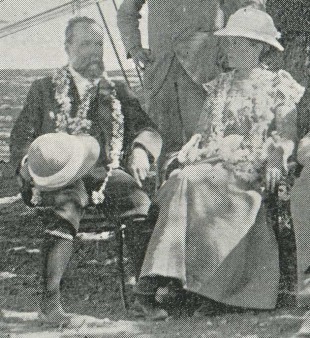
Annie Maunder with her husband E Walter Maunder in India in January 1898. Photo by JPG Smith (detail). From The Indian eclipse (British Astronomical Association)
But why did she resign and what were the factors that influenced the timing of her resignation and her marriage? Did she resign because she didn’t want to be the only woman on the staff once Everett had gone? Who took the decision to remove her from the Astrographic Telescope observing roster when Everett left? Did she resign because she was disillusioned following the appointment of Martin to the post at Dunsink? Did she love Maunder, or was it a marriage of convenience? Did she leave, because she intended to become a full time mother and carer for Maunder’s children or did she leave, as has been stated by others, because having decided to get married, she was forced to resign because of the so called marriage bar? Her letter of resignation which is dated 30 September 1895 states no reason for her resignation and sheds no light on the matter (RGO7/138). There is more information on the marriage bar below.
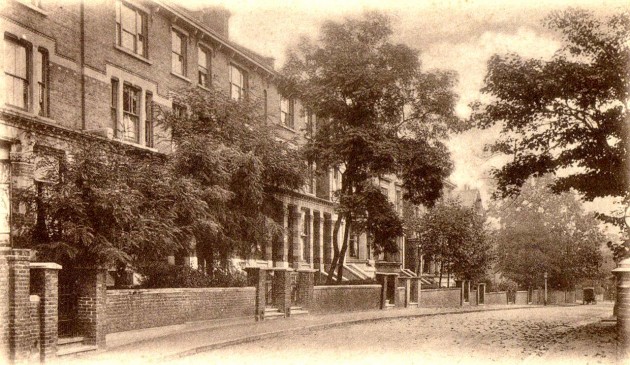
Following their marriage, the Maunders moved into a terrace in Walerand Road, just off Lewisham Hill. Their house (No. 18) was entered by the gate on the left. From a postcard (No. 907) published by Perkins Son & Venimore in about 1904
Although she had resigned from the Observatory, Annie remained an active member of the BAA and accompanied her husband on several eclipse expeditions. Walter officially retired from the Observatory at the age of 62 in November 1913 (after 40 years service), but both he and Annie returned during the First World War, in January 1916, as volunteers. Walter was reinstated into his old post on 1 April 1916, remaining there until 30 September 1919 when he retired for the second time. Rather than leaving as well, Annie stayed on and on the day after his departure, was reinstated as a Computer in the Photo-heliographic Department. She resigned for the second time at the end of 1920, but stayed on as a volunteer until 28 February 1921 (RGO7/266).
Intriguingly, Walter was paid a salary of £150 a year, on the grounds that when added to his pension, it would be equal to the salary he was being paid at the time of his retirement (RGO8/33). When he retired for the second time and Annie re-employed the following day, her salary was also £150 a year or £12.10s. a month inclusive, making her the best paid of all the Computers at that time (RGO8/73).
The employment status of the Computers at Greenwich has always seemed somewhat ambiguous and still needs to be definitively established. Although they were taken on by the Observatory and paid for with Admiralty funds, were they, as one might suppose, technically Admiralty employees and to what extent did the rules of the Civil Service apply, especially given that they were not established members of staff and had no entitlement to a pension?
Many researchers have written about the marriage bar that operated in the British Civil Service during the first half of the twentieth century until finally removed in 1946. Because of the bar, married women, but not single women or widows were excluded from (established?) employment and the norm was for women to have to resign their post if they got married.
The earliest descriptions of women working for the Civil Service seem to date from around 1870. Towards the end of the century, although the number of women was were rising, there were still relative few employed. Although there are case studies relating to the early history of women employed by the Post Office, the Board of Education, the Board of Trade and the Home Office (to name but a few) no material has been identified that relates to women in the Admiralty.
The precise story of how the marriage bar came into being is also somewhat fuzzy. By November 1895 the marriage bar is said to have been extended to all established female labour in ‘public’ departments, although it was not universally applied. In theory therefore it should not have applied to Russell as her post was not an established one.
The Sex Disqualification (Removal) Act 1919 was passed in an attempt to remove the bar from at least some areas of employment. It came into force on 23 December and began:
A person shall not be disqualified by sex or marriage from the exercise of any public function, or from being appointed to or holding any civil or judicial office or post, or from entering or assuming or carrying on any civil profession or vocation, or for admission to any incorporated society (whether incorporated by Royal Charter or otherwise), and a person shall not be exempted by sex or marriage from the liability to serve as a juror:
Provided that –
(a) notwithstanding anything in this section, His Majesty may by Order in Council authorise regulations to be made providing for and prescribing the mode of the admission of women to the civil service of His Majesty, and the conditions on which women admitted to that service may be appointed to or continue to hold posts therein, and giving power to reserve to men any branch of or posts in the civil service in any of His Majesty's possessions overseas, or in any foreign country; and
(b) ... ...
In 1921, however, clause (a) was enacted and an Order in Council limited posts in the Civil Service to women who were either unmarried or widows. The Treasury apparently justifying this position ‘by arguing, somewhat paradoxically, that a woman’s negative right to not be disqualified from holding these posts did not entail a positive entitlement to actually hold the posts’.
So did the introduction of the marriage bar, the Sex Disqualification (Removal) Act and the 1921 order in Council have any impact on Annie? It has already been stated that Annie gave no reason for her resignation in her letter of 1895. The archives are silent too on her second period of employment, as there is seemingly no correspondence on file. Although the timings of Annie’s two departures and the date of her re-employment in 1919 correspond closely with changes in the law and regulations, her post was not an established one and there is no evidence to suggest that the provisions were ever applied in her case.
Opportunity of exploitation?
Many modern commentators speak of Christie’s social innovation. But in truth, although the employment of the Lady Computers did provide women with a much needed entry into the world of professional astronomy, there was never any prospect of them being paid on equal terms with the men. Although the scheme arguably met sufficient of the needs and aspirations of those individuals who took up the posts, it was undoubtedly exploitative and as it turns out, little more than a stop-gap measure. By the time Russell resigned, the problem of insufficient numbers of established staff was about to be resolved and no more ladies were appointed. Indeed, those making enquiries in the early 1900s were told ‘ladies are no longer employed at the Royal Observatory’ (RGO7/140/138).
The next time women were employed at the Observatory was again as Computers and again out of necessity. But this time it was because of the staffing shortages caused by the First World War. Women continued to be employed as Computers until 1936 when the post was abolished, at which point, two of their number had been on the staff for over fifteen years.
Commemorating the women
Until recently, the work of the Greenwich women remained largely unrecognised. Then, rather like the way you wait for a bus and three turn up at once, Annie Maunder’s life and work was commemorated three times in quick succession.
2016: The Royal Astronomical Society inaugurated the Annie Maunder Medal for outreach
2018: The Ulster History Circle erected a Blue Plaque in Strabane
2018: Royal Museums Greenwich named its new telescope the Annie Maunder Astrographic Telescope
2022: Blue Plaque commemorating Annie and Walter Maunder erected at 69 Tyrwhitt Road, Brockley
Meanwhile the careers of the four other women remain largely unknown.
Isabella Clemes (1847–1903)
| 1847 | Born April (Liskeard, Cornwall) |
|
| 1851 | Orphaned: Mother died 10 Nov 1850, father died 1 Sep 1851. Both died of consumption (Bethlem Hospital Records) |
|
| 1871 | Housekeeper to Isaac Brown at 18 Grove Terrace, Leeds (census) | |
| 1876 | Entered Newnham | |
| 1881 | Graduated as Senior Optime. Satirical comment (Pessimismus Triumphatus) about her published in 19 February edition of Punch (see above). Census (3 April) records her profession as a teacher of mathematics and appears to show her living with her uncle William Willis and his family at 49 Palace Grove, Bromley |
|
| 1883 | Advertised for work as a teacher of mathematics and natural philosophy (1 January edition of Journal of Education) | |
| 1886 | A member of the Men and Women’s Club (founded in 1885), Clemes gave a paper to the Club in January on the meaning of morality, in which she argued that morality concerned “both ‘social duties’ ‘(to others)’ and ‘individual duties’ ‘(to the laws of nature as they concern himself alone)’.” (Bland 2001: 23). | |
| 1890 | 14 April, took up post of Computer at Royal Observatory, date of leaving unknown. Joined British Astronomical Association |
|
| 1891 | Treasurer of University Association of Women Teachers (set up in 1883). Date of appointment and resignation not know. Still active at the BAA having nominated the Countess of Portsmouth (between June and October) |
|
| 1892 | Admitted with suicidal thoughts to Bethlem Hospital on 8 March and discharged on 29 June (Bethlem Hospital Records) | |
| 1894 | Working in Girls Grammar School in Hobart, having joined her brother Samuel Clemes in Tasmania | |
| 1896 | Began teaching at The Friends’ School, Hobart, which had been set up by Samuel and where he was the principal | |
| 1900 | Moved to Leslie House School, a new school set up by her brother in Hobart in 1900 | |
| 1903 | Died 24 January (Hobart) |
The following brief account of Isabella’s life was written by her niece Isabella Mary Shoobridge and published in 1933 in a book about her father Samuel Clemes (click here to read as originally published).
‘She was my father’s only sister, and was one or two years his junior, and, being left as orphans at an early age, were everything to each other. Auntie was brought up by her Willis relations, and practically adopted into the family home of Uncle John Willis. She was sent with father to Sidcot School. Her intellectual tastes were late in developing, and at her own wish she left school early and went to keep house for Uncle Isaac Brown, in Leeds, to whom she was much attached. On his death she inherited enough to keep herself independently with a very dear friend in Leeds. She began to wonder if she possessed similar mathematical powers as the rest of her family, and from Edward Carpenter [a gay rights activist], who first stimulated these interests, she conceived the project of going to Newnham College, Cambridge, in 1876.
I am indebted to Miss Alice Gardener, Historical Lecturer, Newnham, for the following notes: — “She was much older than most of the students; very unassuming, and rather delicate in health. She was not one who usually attracted strangers, but those who became her friends grew even more impressed by her singular refinement of character and energy of mind. Perhaps her conspicuous characteristic was a certain moral thoroughness. She delved deeply into philosophy and morals, but there was no trace in her of pedantry or censoriousness, but plenty of human nature with a measure of active kindliness.”
The Friends [Quakers] of that day were not liberal-minded enough for Auntie, so she ceased to become a member of the Society, but always retained some marks of the best kind of Quakerism. She obtained her mathematical Tripos in 1881. For a time she undertook work in connection with the Greenwich Observatory, but, unfortunately, her health broke down. I remember receiving a letter from her expressing her joy at doing national work. On her recovery she joined us in Tasmania, and both Friends’ and Leslie House Schools benefitted from her coaching in higher mathematics. It was always considered an honour to be invited to her room, where, surrounded by her beloved books, she occupied her spare time in writing out pages of solutions to the mathematical problems in the text books. These proved useful to professors and teachers alike.
So she lived amongst us as an endearing personality, always available, and never too busy to attend to our wants. I wish you had known her [my] children, and hope these few inadequate remarks will help to make you love her memory.’
See also: The Friends’ School Hobart: Formation and early development, William Oates (1976)
When Clemes was admitted to Bethlem Hospital on 8 March 1892, she was assessed as being suicidal because she had ‘attempted to get [a] penknife to cut herself’ and was also refusing food. The ‘Supposed cause of [her] insanity’ was recorded as ‘Probably too much brain work and too little food’.
One doctor attending Clemes prior to her admission reported that ‘She is obstinately taciturn & with an expression of extreme melancholy. She has for the last two days steadily refused food. When she speaks she refers with a kind of despair to her great sinfulness.’ Another, stated that Clemes ‘thought herself very wicked – and accused herself to me of being a whore – that she was debased from her pinnacle of pride & could never be forgiven’
Clemes’s breakdown is recorded as having begun on about 24 February and is said to have first manifested itself a week later on 1 March, when according to a neighbour, Clemes came into her ‘home in her nightdress and with bare feet accusing herself of having committed murder and in a very excited state, and that afterwards [she] went up onto the top of the house in the same state’. She also said that Clemes had gone upstairs to see a baby (which did not exist) and that a few hours later she was covered with soot and in bed saying that she ‘had been eating soot as a penance’ and accusing herself of wickedness. Another neighbour said that Clemes ‘had said to her that the voice of God told her to eat no food, that she had a grievous sin to confess and was damned.’
Once in the hospital, Clemes revealed that as well as being the subscription secretary of the University Association of Women Teachers, she was also a teacher of mathematics, and wrote for journals …and that ‘About 5 years ago [she] threw up her work and started a religious novel which was never published; [and had] exhausted all her savings this way’ and that ‘1½ years ago, [she] thought 2 gentlemen were in love with her.’
The day after being admitted, Clemes gave a long account of what had happened which was recorded as follows:
‘It appears that at first she was trying to work out a way of making modern religious and scientific views fit in with each other; just as she had got to the point when everything came out clear, she got an idea that she was to be a second saviour, then “voices” came one set lauding her & her efforts and another set cursing her; then she got ideas that she was wrong after all and only a “blasphemer” She remembers being brought here and thought she was going to the Resurrection.’
By 31 March, the voices had gone, and Clemes was on the mend. She was discharged on 29 June.
Edith Rix (1866–1918)
| |
||
| 1866 | Born 21 February, (Beccles, Suffolk). Baptised 15 April |
|
| 1881 | Boarder at St Mary Magdalen's School, Paddington. Had previously attended All Hallows Orphanage School, Ditchingham (Census & Newnham Register) | |
| 1885 | Lifelong friendship with Lewis Carroll begins (see below). Enters Newnham College |
|
| 1889 | Leaves Newnham without sitting any Tripos exams (Newnham Register) | |
| 1890 | 14 April, took up post of Computer at Royal Observatory. Joined British Astronomical Association | |
| 1892 | Resigned post at Greenwich due to ill health | |
| 1892 | Lewis Carol writes to Alice Ottley on behalf of Rix on 10 July asking if there might be a post suitable for her at her High School | |
| 1893 | Begins work in January as a cataloguer at the Royal Society at £70 a year, but resigns in August (RS:NLB/7/250, NLB/7/261, NLB/7/271, NLB/8/82, NLB/8/308) | |
| 1895 | Living with her parents at The Bank [House], Balygate, Beccles (RS:NLB/11/233) | |
| 1901 | Joins Sutton High School as Assistant Mistress (Newnham Register) | |
| 1902 | Resigns from Sutton High School (Newnham Register) | |
| 1903 | Rejoins British Astronomical Association. Address given as 1 Akehurst Gardens, Roehampton | |
| 1918 | Died 12 January (Newnham Register). Buried Beccles cemetery |
Edith Rix was the eldest of the four children of Frederic Shelly Rix (1836–1933), a Solicitor and his wife Jemima Bostock, née Bradley (1831?–1902). In 1885, she struck up a friendship with the author Lewis Carroll (Charles Dodgson, 1832–1898) who was a fellow and maths tutor at Christ Church College Oxford. Although he made his name with his Alice books in the 1860s, he also wrote on popular mathematics and it was through these writings that he became acquainted with Edith. She came to his attention while he was publishing a ten-part magazine serial called A Tangled Tale (1880–5).
Each episode contained a puzzle, or Knot as Carroll called them, which was described first in story form and then summarised as a ‘maths problem’. Readers sent in solutions, which Carroll then graded. In a later issue, he would publish a solution to the previous Knot and discuss different readers’ answers which included ribbing readers who had answered wrongly. The mathematical interpretations of the Knots were not always straightforward.
Rix sent in an answer to the very last knot which was posed in February 1885. It sufficiently impressed Carroll that they subsequently became lifelong friends and correspondents. They first met on 25 June 1885 (when she was 19). When Carroll published A Tangled Tale in a single volume (1885), he dedicated it to Rix with a poem, starting "Beloved pupil", in which he concealed her name in the second letter of each line.
Beloved pupil! Tamed by thee,
Addish-, Subtrac-, Multiplica-tion,
Division, Fractions, Rule of Three,
Attest thy deft manipulation!
Then onward! Let the voice of Fame
From Age to Age repeat thy story,
Till thou hast won thyself a name
Exceeding even Euclid’s glory!
Harriet Maud Furniss (1866–1949)
| 1866 | Born: Truro, Cornwall. Baptised 20 December (St Mary’s Truro). Father: John Cooper Furniss, Mother: Harriet Furniss |
|
| 1886 | Entered Newnham College as College Scholar (Newnham Register) | |
| 1889 | Awarded aegrotat in maths tripos (Newnham Register) |
|
| 1890 | 14 April, took up post of Computer at Royal Observatory. Joined British Astronomical Association. 30 December, handed in her notice |
|
| 1891 | Resigns from Observatory on 31 January. Census indicates living with widowed mother and sister Charlotte at Lemon House, Lemon Street, Truro, Cornwall. Starts as Assistant Mistress at the Orme Girls’ School, Newcastle-Under-Lyme (Newnham Register) |
|
| 1892 | BAA membership list (30 June 1892) gives address as Lemon House, Truro Sister Charlotte marries John Edward Holmes b.1863 (a land agent & surveyor) |
|
| 1901 | Census: residence 3 Grosvenor Gardens, Newcastle-Under-Lyme. Occupation: Assistant School Teacher | |
| 1903 | Resigned from post at Orme Girls’ School (Newnham Register) | |
| 1904 | Assistant Mistress at Stafford Pupil Teacher Centre (Newnham Register) | |
| 1906 | Head Mistress at at Stafford Pupil Teacher Centre (Newnham Register) | |
| 1907 | Resigned as Head Mistress on death of Sister Charlotte (presumably to look after her children) (Newnham Register) | |
| 1911 | Census: residence Plympton St Mary Devon (living with widowed brother-in-law (John Holmes) and his children: four are listed, aged 6, 7, 14 & 16) |
|
| 1930 | Living with elderly mother at Almorah, Compton Park Road, Plymouth Devon (GWR share register) | |
| 1933 | Mother died aged 96 | |
| 1949 | Died, 31 December (Plymouth Devon) |
Seemingly known as Maud (letter from Mrs Rix to Christie (RGO7/140/85))
Alice Everett (1865–1949)
| 1865 | Born (Glasgow, Scotland). Father: Joseph David Everett (1831–94). Mother: Jessie née Fraser | |
| 1867 | Moved to Ireland when father appointed Professor of Natural Philosophy at Queen's College, Belfast (part of the Queen's University of Ireland) |
|
| 1879 | Father elected a fellow of the Royal Society (of London) | |
| 1884 | Awarded a mathematics scholarship of £50 for five years by Royal University of Ireland (Report of the President of Queen’s College Belfast 1884–85) | |
| 1886 | Entered Girton College | |
| 1887 | Awarded BA degree in Mathematical Science (second class, hons) by Royal University of Ireland (Report of the President of Queen’s College Belfast 1887–88) | |
| 1889 | Graduated from Girton as Senior Optime. Awarded MA in Mathematical Science (second class, hons) by Royal University of Ireland in October (Report of the President of Queen’s College Belfast 1890–91) | |
| 1890 | 14 April, took up post of Computer at Royal Observatory. Joined British Astronomical Association | |
| 1892 | Applied unsuccessfully for post of assistant at Dunsink Observatory (RGO7/138). Elected to the Council of the BAA. Nominated, but not elected as a Fellow of the Royal Astronomical Society. Given a Card of Admission instead |
|
| 1893 | Became secretary of the BAA in October and held this post for two years. November, interviewed by The Sketch |
|
| 1895 | Resigned post at Greenwich on 5 July and moved to Potsdam Observatory for three years covering for a member of staff absent on military service. Said by Brück to have started work there on 1 October (Brück, M. T. (1995)) | |
| 1898 | Assistant for one year at observatory at Vassar College USA (Brück, M. T. (1994)) | |
| 1899 | Applied unsuccessfully for a job at the Lick Observatory (Brück, M. T. (1994)) | |
| 1900 | 31 January, re-elected as a member of the BAA her membership presumably having elapsed. End of career as a professional astronomer (Brück, M. T. (1994)) | |
| 1905 | Observed solar eclipse with the Crommelins and others in Majorca (link) | |
| 1914 | Received an invitation from the RAS in October to attend meetings (RAS letters). It is not known if she received one every year since receiving the first in 1892 | |
| 1916 | Spent a year working in the optical laboratory of Hilgers, London (Brück, M. T. (1994)) | |
| 1917 | Joined National Physical Laboratory (Brück, M. T. (1994)) | |
| 1925 | Retired from National Physical Laboratory aged 60 (Brück, M. T. (1994)) | |
| 1949 | Died (London) |
See also
Lady Computers at Greenwich in the Early 1890s. Brück, M. T. (1995)
Annie Russell (1868–1947)
| 1868 | Born 14 April (Strabane, County Tyrone, Ireland) |
|
| 1886 | Entered Girton College | |
| 1889 | Graduated as Senior Optime | |
| 1890 | Mathematics teacher at the Ladies’ High School Jersey (Brück, M. T. (1994)) | |
| 1891 | 1 September, took up post of Computer at Royal Observatory and joined British Astronomical Association | |
| 1892 | Nominated, but not elected as a Fellow of the Royal Astronomical Society. Given a Card of Admission instead | |
| 1894 | Became editor of BAA Journal in October and held this post for two years | |
| 1895 | Resigned post at the Observatory 31 October. Married E. Walter Maunder 28 December |
|
| 1916 | Rejoined the staff of the Royal Observatory as a volunteer in January. Elected a Fellow of the RAS in November following a change to its Charter |
|
| 1919 | Re-employed as a Computer at the Observatory on 1 October | |
| 1921 | Resigned from the Observatory for the second time at the end of 1920, but stayed on as a volunteer until 28 February 1921. (RGO7/266) | |
| 1928 | Husband (E. Walter Maunder) died |
|
| 1947 | Died 15 September |
Of all the Greenwich women, Russell is the one that historians have written the most about. Further details about other aspects of her life can be found in the following papers:
Obituary: Annie Scott Dill Maunder. MNRAS (1948)
Lady Computers at Greenwich in the Early 1890s. Brück, M. T. (1995)
Further reading
A short history of Newnham College Cambridge. Alice Gardner (1921)
Women at Cambridge. Rita McWilliams-Tullberg (1975)
Women Astronomers in Britain, 1780-1930, Kidwell. P. (1984)
Lady Computers at Greenwich in the Early 1890s. Brück, M. T. (1995)
Making Visible the First Women in Astronomy in Australia: The Measurers and Computers Employed for the Astrographic Catalogue. T. Stevenson
Women servants of the State (1870–1938). Hilda Martindale (1938)
Women in the Civil Service - History
Banishing the Beast: Feminism, Sex and Morality. Lucy Bland (1995)
History of the Royal Astronomical Society (1820–1920). Dreyer (1923)
Acknowledgements
Special thanks are due to the Greenwich Heritage Centre for permission to reproduce the 1897 photograph of the partially completed South Building.
The following images are © National Portrait Gallery, London. Reproduced under a Creative Commons Attribution-NonCommercial-NoDerivs 3.0 Unported (CC BY-NC-ND 3.0) licence.
Portrait of Anne Clough. Albumen cabinet card by an unknown photographer, 1880–1892. National Portrait Gallery Object ID: NPG x6175.
Portrait of Herbert Turner. Bromide print by Walter Stoneman, 1918. National Portrait Gallery Object ID: NPG x185770.
Portrait of Frank Dyson. Bromide print by Walter Stoneman, 1919. National Portrait Gallery Object ID: NPG x88116.
© 2014 – 2025 Graham Dolan
Except where indicated, all text and images are the copyright of Graham Dolan
